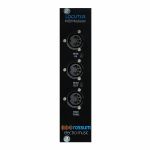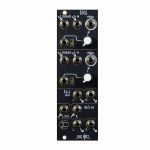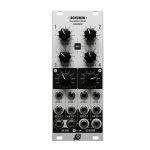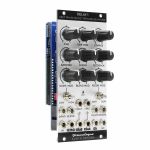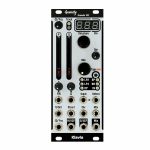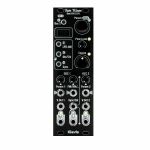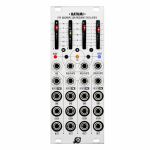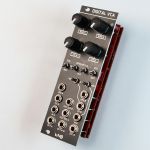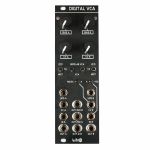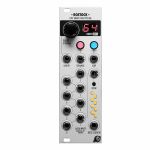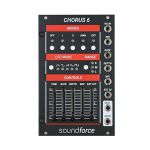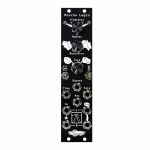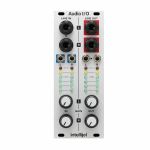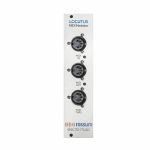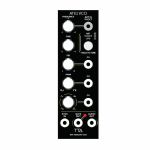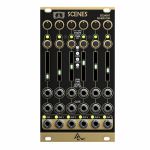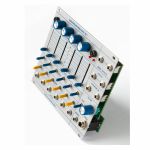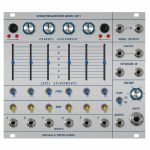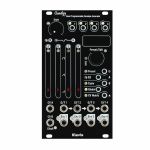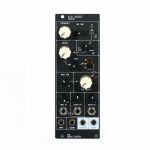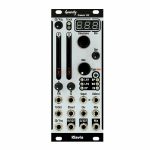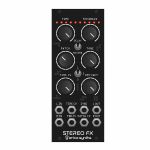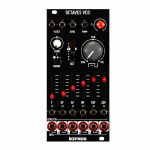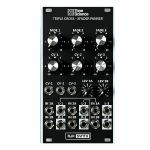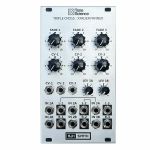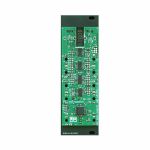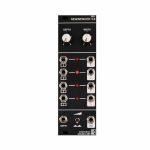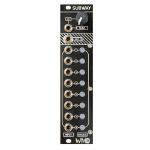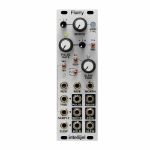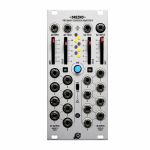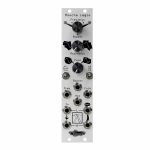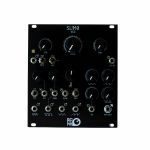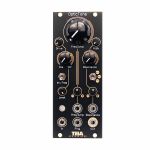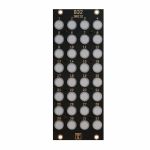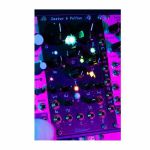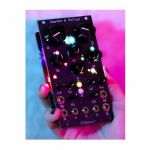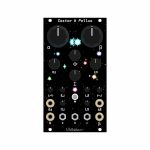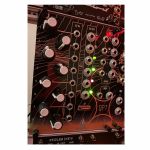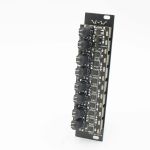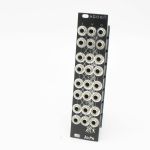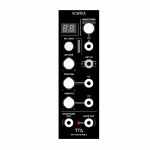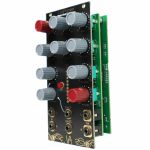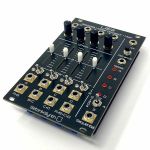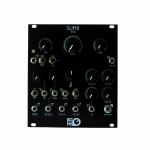安全なお買い物
Studio equipment
Our full range of studio equipment from all the leading equipment and software brands. Guaranteed fast delivery and low prices.
安全なお買い物
DJ equipment
Our full range of DJ equipment from all the leading equipment and software brands. Guaranteed fast delivery and low prices. Visit Juno DJ
Filter
Stock
Coming Soon
Equipment
Format
Release Date
Featured
Price
Tags
Rossum Electro-Music Locutus MIDI Mediator Module For Assimil8or (black) (expander/MIDI/utility module)
Cat: 996361 Rel: 15 Apr 24
MIDI mediator module for Assimil8or - 6HP
Notes: LOCUTUS is designed to interface Assimil8or with MIDI instruments, controllers, and sequencers to provide multichannel modulation and new polyphonic possibilities.
LOCUTUS includes a special attached cable to connect to the Assimil8or CPU behind the panel.
LOCUTUS is 6 HP wide and 25mm deep.
MIDI sources connected to LOCUTUS’ MIDI IN port can be used to modulate Assimil8or parameters using velocity, channel pressure, and MIDI CC (Continuous Controller) messages, select presets using MIDI Program Change (PC) messages, and/or optionally trigger Assimil8or channels with MIDI notes using user-selectable assignment modes. MIDI Setups can be configured with assignment modes including Dynamic, which intelligently cycles through Assimil8or’s channels to easily create polyphonic patches, Multi assignment modes ideal for playing multitimbral Assimil8or patches with MIDI sequencers, SP-1200 modes designed especially for triggering Assimil8or with SP-1200’s MIDI output, and more.
Locutus’ MIDI OUT port can be used to optionally transmit program messages when presets are changed and/or to send MIDI CC data based on the analog control voltages patched to Assimil8or’s 24 CV inputs. Using the new CV-to-MIDI options, Assimil8or and Locutus can be configured to control and modulate MIDI equipment using a eurorack modular system.
… Read moreLOCUTUS includes a special attached cable to connect to the Assimil8or CPU behind the panel.
LOCUTUS is 6 HP wide and 25mm deep.
MIDI sources connected to LOCUTUS’ MIDI IN port can be used to modulate Assimil8or parameters using velocity, channel pressure, and MIDI CC (Continuous Controller) messages, select presets using MIDI Program Change (PC) messages, and/or optionally trigger Assimil8or channels with MIDI notes using user-selectable assignment modes. MIDI Setups can be configured with assignment modes including Dynamic, which intelligently cycles through Assimil8or’s channels to easily create polyphonic patches, Multi assignment modes ideal for playing multitimbral Assimil8or patches with MIDI sequencers, SP-1200 modes designed especially for triggering Assimil8or with SP-1200’s MIDI output, and more.
Locutus’ MIDI OUT port can be used to optionally transmit program messages when presets are changed and/or to send MIDI CC data based on the analog control voltages patched to Assimil8or’s 24 CV inputs. Using the new CV-to-MIDI options, Assimil8or and Locutus can be configured to control and modulate MIDI equipment using a eurorack modular system.
1 in stock $226.26
Click for better price!
or call +44 20 7424 1960
quote 996361
quote 996361
Make Noise DXG Dual Stereo Low Pass Gate & Mixer Module (dual/strereo/low pass gate/mixer module)
Cat: 992443 Rel: 29 Jan 24
Dual stereo low pass gate & mixer module - 8HP
Notes: The Dual Stereo Gate (DXG) music synthesizer module is a Dual Stereo Low Pass Gate and Mixer. It follows in the footsteps of the QMMG, Optomix, RxMx, DynaMix, and LxD. Unlike its predecessors, the DXG is specifically oriented around mixing stereo signals, making it an important addition to any system containing modules like XPO, QPAS, Morphagene, Mimeophon, and other stereo modules by Make Noise or others.
Unique to the DXG is a new low pass gate circuit that does not use vactrols. This circuit is 100% analogue and its response was arrived at after many months tailoring it to meet or exceed the expectations that have been set by all the vactrol low pass gates that Make Noise has created over the years.
In the past, Make Noise produced the Dynamix module and Dynamics circuit in the 0-COAST, both of which are vactrolless LPGs; however, the DXG is a completely new approach which better implements the gentle single pole filtering of a low pass gate, while also emulating the slow decay and memory of the vactrol based low pass gate. This new circuit makes possible the consistency of response necessary for versatile stereo use, while also keeping the module small and affordable so that it can be a key part of just about any modular system.
As on all of Make Noise's low pass gates, the DXG's Control parameter is used to set both the amplitude and the frequency content of the sound that passes through it. The control parameter tends to open faster than it closes, imparting a subtle decay phase onto any envelope shape that is used to modulate it.
Unlike previous low pass gates made by Make Noise, all the DXG's inputs and outputs are stereo. Each set of inputs is normalled so that the left input can be used for a mono signal, sending a copy to both left and right outputs. The Auxiliary inputs are also a stereo pair with mono normalization. These normalizations allow for the DXG to be used as a simple three channel stereo mixer, with one or two of the channels additionally being used for dynamics control and note event generation. The Aux inputs can be used to chain together larger decentralized mixes using additional DXG modules, or X-PAN, Optomix, modDemix etc.
Features
- Make Noise's first Stereo Low Pass Gate
- Vactrol-free design for classic Low Pass Gate sounds, but with the balance and consistency needed for true Stereo
- Fully Stereo i/o for easy integration into a Stereo-equipped modular synthesizer
- All Left inputs normalled for easy use with Mono signals
- STRIKE Input allows use of Gate signal to trigger Low Pass Gate circuit, creating "plucking" or "pinging" sound from any Gate
- Summing stage with Stereo AUXiliary IN allows for chaining of multiple units, creating larger mixes
- Part of a decentralized mix console integrated throughout the system along with X-PAN, Optomix, XOH, etc.
- Pairs well with XPO, QPAS, Morphagene, Mimeophon, Spectraphon etc.
Width: 8hp
Power:
74mA @ +12V
86mA @ -12V
Module Depth (incl power cable): 43mm
… Read moreUnique to the DXG is a new low pass gate circuit that does not use vactrols. This circuit is 100% analogue and its response was arrived at after many months tailoring it to meet or exceed the expectations that have been set by all the vactrol low pass gates that Make Noise has created over the years.
In the past, Make Noise produced the Dynamix module and Dynamics circuit in the 0-COAST, both of which are vactrolless LPGs; however, the DXG is a completely new approach which better implements the gentle single pole filtering of a low pass gate, while also emulating the slow decay and memory of the vactrol based low pass gate. This new circuit makes possible the consistency of response necessary for versatile stereo use, while also keeping the module small and affordable so that it can be a key part of just about any modular system.
As on all of Make Noise's low pass gates, the DXG's Control parameter is used to set both the amplitude and the frequency content of the sound that passes through it. The control parameter tends to open faster than it closes, imparting a subtle decay phase onto any envelope shape that is used to modulate it.
Unlike previous low pass gates made by Make Noise, all the DXG's inputs and outputs are stereo. Each set of inputs is normalled so that the left input can be used for a mono signal, sending a copy to both left and right outputs. The Auxiliary inputs are also a stereo pair with mono normalization. These normalizations allow for the DXG to be used as a simple three channel stereo mixer, with one or two of the channels additionally being used for dynamics control and note event generation. The Aux inputs can be used to chain together larger decentralized mixes using additional DXG modules, or X-PAN, Optomix, modDemix etc.
Features
- Make Noise's first Stereo Low Pass Gate
- Vactrol-free design for classic Low Pass Gate sounds, but with the balance and consistency needed for true Stereo
- Fully Stereo i/o for easy integration into a Stereo-equipped modular synthesizer
- All Left inputs normalled for easy use with Mono signals
- STRIKE Input allows use of Gate signal to trigger Low Pass Gate circuit, creating "plucking" or "pinging" sound from any Gate
- Summing stage with Stereo AUXiliary IN allows for chaining of multiple units, creating larger mixes
- Part of a decentralized mix console integrated throughout the system along with X-PAN, Optomix, XOH, etc.
- Pairs well with XPO, QPAS, Morphagene, Mimeophon, Spectraphon etc.
Width: 8hp
Power:
74mA @ +12V
86mA @ -12V
Module Depth (incl power cable): 43mm
3 in stock $205.50
Click for better price!
or call +44 20 7424 1960
quote 992443
quote 992443
Xaoc Devices Bohumin 1966 Mixing Console Commander Module (expander module)
Cat: 945623 Rel: 10 Oct 23
An expander module for the Ostrawa full stereo mixer in 10HP.
Notes: Part of Xaoc's range of modular mixing tools, the Bohumin 1966 is a commander module for Ostrawa stereo mixer modules, adding a second stereo aux bus, voltage control and manual attenuators with clickless mutes
Supplier's notes:
Bohumin [bo'xumin] is an expander for Xoac Deives' Ostrawa full stereo mixer module. By connecting to Bohumin, Ostrawa gains a second full stereo AUX bus with voltage control over the amount of the effect on each channel. Bohumin features manual attenuators for stereo returns of both AUX A and AUX B, as well as four gate inputs for automated clickless muting of each stereo input channel. Please note that Bohumin is not compatible with Ostrawa's sister module Praga. Similarly, Praga's expander Hrad cannot be connected to Ostrawa. However it is possible to chain any combination of Ostrawas and Pragas, and each of them may have its corresponding expander attached.
Technical details
10hp, skiff friendly
Power drawn from Ostrawa: +50mA/-40mA
… Read moreSupplier's notes:
Bohumin [bo'xumin] is an expander for Xoac Deives' Ostrawa full stereo mixer module. By connecting to Bohumin, Ostrawa gains a second full stereo AUX bus with voltage control over the amount of the effect on each channel. Bohumin features manual attenuators for stereo returns of both AUX A and AUX B, as well as four gate inputs for automated clickless muting of each stereo input channel. Please note that Bohumin is not compatible with Ostrawa's sister module Praga. Similarly, Praga's expander Hrad cannot be connected to Ostrawa. However it is possible to chain any combination of Ostrawas and Pragas, and each of them may have its corresponding expander attached.
Technical details
10hp, skiff friendly
Power drawn from Ostrawa: +50mA/-40mA
2 in stock $233.52
Joranalogue Delay 1 Split-Phase Bucket Brigade Delay Line Module (effect synth module)
Cat: 881426 Rel: 10 Aug 23
Delay 1 is a fully analogue BBD-based delay module with a multitude of features geared towards modern musical use.
Notes: Bucket brigade delay gets pushed into exciting creative territory with this beauty from Joranalogue. Precise analogue delay with loads of character, capable of simple chorus and flanger or more exotic Karplus-Strong synthesis and comb filtering.
Supplier's Notes:
While digital audio processors are often plagued by latency issues, analogue circuits are known for their instant response. But what if you want to delay a signal on purpose, without the use of tape or digital memory? Enter the bucket brigade delay (BBD) line: a series of capacitor 'buckets', which pass the incoming signal along at a high rate in order to delay it.
Delay 1 is a fully analogue BBD-based delay module with a multitude of features geared towards modern musical use. An integrated temperature-compensated, high-frequency voltage controlled oscillator (VCO) provides the 'clock' signal necessary to drive the delay line within 1 to 50 ms.
By increasing the drive frequency to over 20 kHz, the classic 'BBD clock whine' problem is solved, while still providing a wide range in delay time. Classic chorus, flanger and echo effects are easily achieved using the dry/wet blend, feedback and damping parameters.
To greatly reduce distortion and noise, Delay 1 includes a newly developed control circuit. The improved fidelity is maintained at a multitude of signal levels by an integrated high-performance compander, while maintaining signal dynamics.
The module's 'split phase' topology provides two different dry/wet mixes, which may be used to convert mono signals to stereo, for complementary comb filtering and more.
Delay 1 also allows you to experiment with Karplus-Strong synthesis, an exciting technique to create string and percussion type sounds. This is made easy by an integrated noise transient generator, driven by the 'pluck' input, and by the clock VCO's 1 volt per octave response.
By re-engineering the classic analogue delay line, Delay 1 brings the unique magic of BBDs into the contemporary electronic musician's arsenal.
Analogue bucket brigade delay line.
Integrated temperature-stable high-frequency BBD clock VCO with fine and coarse tuning.
Split-phase topology with additive and subtractive dry/wet blend outputs.
Blend, feedback and damping (feedback filter) parameters. Positive or negative feedback with low or high pass filtering.
High-performance BBD drive circuitry and transparent compander chain ensure optimal signal fidelity.
Dedicated pluck trigger input for Karplus-Strong synthesis.
High-frequency BBD clock input and output to synchronise multiple delay lines.
Impedance-compensated outputs with dual-colour LEDs.
Trim potentiometer accessible from the front panel.
Premium mounting hardware: black screws, black nylon washers and matching hex key.
High-quality components and assembly; designed and made in Belgium.
12 HP | +12: 125 mA, -12: 95 mA
… Read moreSupplier's Notes:
While digital audio processors are often plagued by latency issues, analogue circuits are known for their instant response. But what if you want to delay a signal on purpose, without the use of tape or digital memory? Enter the bucket brigade delay (BBD) line: a series of capacitor 'buckets', which pass the incoming signal along at a high rate in order to delay it.
Delay 1 is a fully analogue BBD-based delay module with a multitude of features geared towards modern musical use. An integrated temperature-compensated, high-frequency voltage controlled oscillator (VCO) provides the 'clock' signal necessary to drive the delay line within 1 to 50 ms.
By increasing the drive frequency to over 20 kHz, the classic 'BBD clock whine' problem is solved, while still providing a wide range in delay time. Classic chorus, flanger and echo effects are easily achieved using the dry/wet blend, feedback and damping parameters.
To greatly reduce distortion and noise, Delay 1 includes a newly developed control circuit. The improved fidelity is maintained at a multitude of signal levels by an integrated high-performance compander, while maintaining signal dynamics.
The module's 'split phase' topology provides two different dry/wet mixes, which may be used to convert mono signals to stereo, for complementary comb filtering and more.
Delay 1 also allows you to experiment with Karplus-Strong synthesis, an exciting technique to create string and percussion type sounds. This is made easy by an integrated noise transient generator, driven by the 'pluck' input, and by the clock VCO's 1 volt per octave response.
By re-engineering the classic analogue delay line, Delay 1 brings the unique magic of BBDs into the contemporary electronic musician's arsenal.
Analogue bucket brigade delay line.
Integrated temperature-stable high-frequency BBD clock VCO with fine and coarse tuning.
Split-phase topology with additive and subtractive dry/wet blend outputs.
Blend, feedback and damping (feedback filter) parameters. Positive or negative feedback with low or high pass filtering.
High-performance BBD drive circuitry and transparent compander chain ensure optimal signal fidelity.
Dedicated pluck trigger input for Karplus-Strong synthesis.
High-frequency BBD clock input and output to synchronise multiple delay lines.
Impedance-compensated outputs with dual-colour LEDs.
Trim potentiometer accessible from the front panel.
Premium mounting hardware: black screws, black nylon washers and matching hex key.
High-quality components and assembly; designed and made in Belgium.
12 HP | +12: 125 mA, -12: 95 mA
6 in stock $254.28
Klavis Grainity Digitally-Controlled Full-Analogue Path Granular & Multi-Mode VCF Module (silver) (filter/phase shifter/pitch shifter module)
Cat: 934965 Rel: 19 Dec 23
Digitally-controlled full-analogue path granular & multi-mode VCF module in 10HP.
Notes: A unique analogue take on granular synthesis, inspired by Yannis Xenakis, the Grainity pairs a granular filter with a multimode filter to create new textures and harmonics.
Supplier's Notes:
The Grainity brings a unique and never-heard-before concept to the world of analogue VCF.
While being based on analogue filtering only, the Grainity expands and enriches the sound in creating subharmonics, harmonies, unison, flanging effects and formant filtering all at once.
The module presents two sections, the granular filter itself and a typical multimode filter, each with its own output.
A third output offers a mix of both filter paths. Numerous controls and CV allow a very wide palette of results.
What is the Grainity
Granular?
The word granular was chosen for this filter module in relation to the concept invented by the composer Yannis Xenakis, and which is described as assembling small chops of sounds - he called grains - according to a pattern.
This is exactly what the Grainity does, no more no less ... but, digital control allows doing it in ways that are decades away from what tape and scissors allowed at the time.
Technology wise ...
In the granular section, the incoming sound cycle is determined in order to step through various filtering and phase variations of itself according to predefined patterns called structures.
The controls allow alterations to the cycling phase, cycling frequency offset (tuning), structure selection and frequency division of the filters cycling. This comes in addition to the usual filter frequency and resonance controls.
What the Grainity is not
Technology wise ...
Despite relying on a microprocessor, the Grainity is not a digital audio processor. At any time, the sound remains in the analog domain and goes through analog circuits from in to out.
The digital processor does not convert or generate audio signals; it is there to control the analog circuitry and manage the interface and display.
Sound wise ...
Several digital modules offering granular processing rely on the layering of sound grains, which leads to blurry and cloudy textures.
Layering of the grains is a late addition to the concept of granular synthesis and is not a mandatory feature of the concept.
The Grainity does not use delay lines or sampling memory but is nevertheless true to the foundations of the granular synthesis concept.
The granular VCF in the Grainity is unconventional in that, most of times, it is not filtering the sound in the common expectation of removing something. Typically, the granular process adds more than it removes by expanding both the lower range, creating subharmonics, and the upper harmonic contents in multiples ways.
Dimensions
10 HP
21 mm deep
Current Draw
101 mA +12V
59 mA -12V
… Read moreSupplier's Notes:
The Grainity brings a unique and never-heard-before concept to the world of analogue VCF.
While being based on analogue filtering only, the Grainity expands and enriches the sound in creating subharmonics, harmonies, unison, flanging effects and formant filtering all at once.
The module presents two sections, the granular filter itself and a typical multimode filter, each with its own output.
A third output offers a mix of both filter paths. Numerous controls and CV allow a very wide palette of results.
What is the Grainity
Granular?
The word granular was chosen for this filter module in relation to the concept invented by the composer Yannis Xenakis, and which is described as assembling small chops of sounds - he called grains - according to a pattern.
This is exactly what the Grainity does, no more no less ... but, digital control allows doing it in ways that are decades away from what tape and scissors allowed at the time.
Technology wise ...
In the granular section, the incoming sound cycle is determined in order to step through various filtering and phase variations of itself according to predefined patterns called structures.
The controls allow alterations to the cycling phase, cycling frequency offset (tuning), structure selection and frequency division of the filters cycling. This comes in addition to the usual filter frequency and resonance controls.
What the Grainity is not
Technology wise ...
Despite relying on a microprocessor, the Grainity is not a digital audio processor. At any time, the sound remains in the analog domain and goes through analog circuits from in to out.
The digital processor does not convert or generate audio signals; it is there to control the analog circuitry and manage the interface and display.
Sound wise ...
Several digital modules offering granular processing rely on the layering of sound grains, which leads to blurry and cloudy textures.
Layering of the grains is a late addition to the concept of granular synthesis and is not a mandatory feature of the concept.
The Grainity does not use delay lines or sampling memory but is nevertheless true to the foundations of the granular synthesis concept.
The granular VCF in the Grainity is unconventional in that, most of times, it is not filtering the sound in the common expectation of removing something. Typically, the granular process adds more than it removes by expanding both the lower range, creating subharmonics, and the upper harmonic contents in multiples ways.
Dimensions
10 HP
21 mm deep
Current Draw
101 mA +12V
59 mA -12V
5 in stock $257.40
Klavis Twin Waves MK2 Voltage-Controlled Dual VCO/LFO/Random Module (black) (digital/LFO/oscillator/dual/stereo/noise/quantizer/ring modulator/random synth module)
Cat: 951618 Rel: 26 Feb 24
Voltage-controlled dual VCO, LFO and random module - 8HP.
Notes: Two oscillators independently set as VCO, LFO, or random generator
This new version replaces the original Twin Waves. All features of the former are retained. You can check all videos, reviews and comments of V1, being sure to benefit of all in the MKII version :-)
Features in VCO mode:
V/Oct tracking over 10 octaves
Tuning lock with octave selection
Through zero and linear FM
Sub-octave output
Hard & soft synchronization
VCA control and CV algorithms selection
Quantizer with various scales
20 algorithm-based synthesis types among:
Wave shaping
Phase modulation
Phase positioning of multiple waves
Up to 5 stacked oscillators in tunable unison
Self-sync with phantom oscillator
Additive synthesis (7 waves)
Variable bit reduction (bit-crushing)
Ring modulator with its own 2nd oscillator
Noise with LPF, BPF, or resonant filter
Features in LFO mode:
Simultaneous signal and trigger outputs
External wave synchronization
Clock controlled rate with voltage controlled multiplier and divider
CV and knob control of output level
Algorithm based wave engine with a selection of:
Wave shaping
Phase modulation
Random levels and vectors (also Brownian)
Randomly spaced triggers and waves
Display with contextual icons and instant reminder help text
LEDs indicating potentiometer vs. value matching, switch settings and output signals
Automatically saved settings for instant recall at power on
Firmware update by playing an audio file via the front panel
Compact and skiff-friendly module
Dimensions
8 HP
21 mm deep
Current Draw
52 mA +12V
17 mA -12V
0 mA 5V
… Read moreThis new version replaces the original Twin Waves. All features of the former are retained. You can check all videos, reviews and comments of V1, being sure to benefit of all in the MKII version :-)
Features in VCO mode:
V/Oct tracking over 10 octaves
Tuning lock with octave selection
Through zero and linear FM
Sub-octave output
Hard & soft synchronization
VCA control and CV algorithms selection
Quantizer with various scales
20 algorithm-based synthesis types among:
Wave shaping
Phase modulation
Phase positioning of multiple waves
Up to 5 stacked oscillators in tunable unison
Self-sync with phantom oscillator
Additive synthesis (7 waves)
Variable bit reduction (bit-crushing)
Ring modulator with its own 2nd oscillator
Noise with LPF, BPF, or resonant filter
Features in LFO mode:
Simultaneous signal and trigger outputs
External wave synchronization
Clock controlled rate with voltage controlled multiplier and divider
CV and knob control of output level
Algorithm based wave engine with a selection of:
Wave shaping
Phase modulation
Random levels and vectors (also Brownian)
Randomly spaced triggers and waves
Display with contextual icons and instant reminder help text
LEDs indicating potentiometer vs. value matching, switch settings and output signals
Automatically saved settings for instant recall at power on
Firmware update by playing an audio file via the front panel
Compact and skiff-friendly module
Dimensions
8 HP
21 mm deep
Current Draw
52 mA +12V
17 mA -12V
0 mA 5V
3 in stock $232.49
Xaoc Devices Batumi II 1974 Quadruple Low Frequency Oscillator Module (digital/LFO/oscillator/quad/random/clock generator/CV modulation module)
Cat: 979276 Rel: 13 Feb 24
Quadruple low frequency oscillator module - 10HP
Notes: An updated version of the excellent Batumi quad LFO, version II introduces performance updates plus compatibility with the new Poti II expander. Original Poti I breakout functions are now included in the Batumi II.
Supplier's Notes:
Xaoc Devices presents Batumi II - a greatly improved and enhanced new iteration of the modern day classic that is/was the original Batumi, preserving its layout and form factor. The premise remains the same: four LFO's with individual outputs for sine, assign and rectangle waves. The channels can operate independently or they can be linked - phase shifted, divided or multiplied (new mode alert) with regard to the first channel. Multiple major and minor improvements have been implemented, e.g. when synced to an external clock source, each channel's frequency slider selects a clock division for that channel's outputs.
Xaoc Devices have managed to incorporate the features of the original expander into Batumi II (sync mode switching and assign waveform selection) without changing the size of the module which opened up new possibilities for the new optional expander. The Poti II expander for Batumi II adds multi destination inputs for sine wavefolding, assign output waveform selection or rectangle pulse modulation with the destination set for each channel independently. Poti II also features frequency input attenuation as well as sine and assign output attenuation. All adjustments may be performed separately for each individual channel or for all channels simultaneously.
The Batumi II software has been rewritten from scratch to ensure best performance. The hardware has also been updated to allow for V/oct tracking and stable operation up to audio rates (more powerful CPU, precise, wideband converters, antialiased waveforms).
-4 LFO's
- redesigned from scratch - both the hardware and software
- new waveforms for the assign output (including random)
- new frequency multiplication mode
- all features of the Poti expander incorporated into the main module
- very wide frequency range well into audio rate
- 1V/oct tracking = so can be used as 4 VCO's
- in the Phase/Divide/Mult modes the random waves at the ASGN output follow the values available in the master/A channel
- 10HP
- +90/-50mA
… Read moreSupplier's Notes:
Xaoc Devices presents Batumi II - a greatly improved and enhanced new iteration of the modern day classic that is/was the original Batumi, preserving its layout and form factor. The premise remains the same: four LFO's with individual outputs for sine, assign and rectangle waves. The channels can operate independently or they can be linked - phase shifted, divided or multiplied (new mode alert) with regard to the first channel. Multiple major and minor improvements have been implemented, e.g. when synced to an external clock source, each channel's frequency slider selects a clock division for that channel's outputs.
Xaoc Devices have managed to incorporate the features of the original expander into Batumi II (sync mode switching and assign waveform selection) without changing the size of the module which opened up new possibilities for the new optional expander. The Poti II expander for Batumi II adds multi destination inputs for sine wavefolding, assign output waveform selection or rectangle pulse modulation with the destination set for each channel independently. Poti II also features frequency input attenuation as well as sine and assign output attenuation. All adjustments may be performed separately for each individual channel or for all channels simultaneously.
The Batumi II software has been rewritten from scratch to ensure best performance. The hardware has also been updated to allow for V/oct tracking and stable operation up to audio rates (more powerful CPU, precise, wideband converters, antialiased waveforms).
-4 LFO's
- redesigned from scratch - both the hardware and software
- new waveforms for the assign output (including random)
- new frequency multiplication mode
- all features of the Poti expander incorporated into the main module
- very wide frequency range well into audio rate
- 1V/oct tracking = so can be used as 4 VCO's
- in the Phase/Divide/Mult modes the random waves at the ASGN output follow the values available in the master/A channel
- 10HP
- +90/-50mA
out of stock $268.82
WMD Digital VCA MKIII Dual Zero-Crossing VCA & Polariser Module (polariser/ring modulator/sample & hold/VCA module)
Cat: 1008017 Rel: 27 Mar 24
Dual digital VCA module with zero crossing detection, polarisation, noise, sample & hold - 8HP
Notes: Another update for WMD's clever dual VCA, this time a little bigger to give more control. Digital control of CV and attenuation gives lots of creative options. Third time's a charm.
Supplier's Notes:
WMD have done several designs of this circuit over the years, the first one had no knobs, the second was too small, the MKIII is finally how this circuit should be packaged. This module does some really cool stuff and is super useful in any system.
The Digital VCA lets signal through like a normal VCA, but the CV and attenuation level is controlled digitally. This lets us do things like wait until there is a zero crossing to change the amplitude, resulting in clickless amplitude changes.
The Trigger mode causes the VCA to only update when a trigger is received. The addition of a noise circuit for each side let us do a very quick and easy sample and hold that never droops. With no input, 5V is normaled to the attenuator, so you get a 0-5V sample and hold. In Bipolar mode, you can get -5 to +5V.
Both sides have bipolar VCA mode (polarizer), which lets them invert the signal when negative CV comes in. Also known as ring modulation. With the zero crossing detector, this can produce some super wild wave shapes.
Features
Dual VCA Design
Unipolar or Bipolar Operation
DC Coupled Analogue Signal Path
Low Distortion / Low Noise
VCA Closes Completely
Zero Crossing Detector Mode
Trigger Mode
Two Independent Noise Sources
8 bit CV resolution
Great for Fast Envelopes and Sine Bass Sounds
Specifications
Power: +65mA, -45mA
Width: 8HP
Depth: 35mm with cables
Height: Eurorack 3U (128.5mm)
Board Height Behind Panel: 112mm
CV/Signal Input Impedance: 100k
Output Impedance: 1k
UPD in 3.3V Threshold Schmitt Trigger
ZCD produces 15us 5V pulse
5V CV to fully open VCA
Linear VCA response
20Vpp signal handling
… Read moreSupplier's Notes:
WMD have done several designs of this circuit over the years, the first one had no knobs, the second was too small, the MKIII is finally how this circuit should be packaged. This module does some really cool stuff and is super useful in any system.
The Digital VCA lets signal through like a normal VCA, but the CV and attenuation level is controlled digitally. This lets us do things like wait until there is a zero crossing to change the amplitude, resulting in clickless amplitude changes.
The Trigger mode causes the VCA to only update when a trigger is received. The addition of a noise circuit for each side let us do a very quick and easy sample and hold that never droops. With no input, 5V is normaled to the attenuator, so you get a 0-5V sample and hold. In Bipolar mode, you can get -5 to +5V.
Both sides have bipolar VCA mode (polarizer), which lets them invert the signal when negative CV comes in. Also known as ring modulation. With the zero crossing detector, this can produce some super wild wave shapes.
Features
Dual VCA Design
Unipolar or Bipolar Operation
DC Coupled Analogue Signal Path
Low Distortion / Low Noise
VCA Closes Completely
Zero Crossing Detector Mode
Trigger Mode
Two Independent Noise Sources
8 bit CV resolution
Great for Fast Envelopes and Sine Bass Sounds
Specifications
Power: +65mA, -45mA
Width: 8HP
Depth: 35mm with cables
Height: Eurorack 3U (128.5mm)
Board Height Behind Panel: 112mm
CV/Signal Input Impedance: 100k
Output Impedance: 1k
UPD in 3.3V Threshold Schmitt Trigger
ZCD produces 15us 5V pulse
5V CV to fully open VCA
Linear VCA response
20Vpp signal handling
1 in stock $234.57
Click for better price!
or call +44 20 7424 1960
quote 1008017
quote 1008017
Xaoc Devices Rostock 1989 Binary Data Pipeline Module (CV modulation/digital/looper/delay synth module)
Cat: 945640 Rel: 15 Jun 23
A data pipeline, a FIFO (first in, first out) shift register or a digital delay module in 8HP.
Notes: Part of Xaoc's Leibniz binary system, the Rostock is a digital delay line capable of processing triggers, audio, CV and video signals. Another useful module from the unique Leibniz series.
Supplier's Notes:
Rostock is a component of the Leibniz Binary Subsystem. It is a data pipeline, a FIFO (first in - first out) shift register, or a very short digital delay. The module operates similarly to a BBD delay or an ASR (analogue shift register), except that it is digital. It consists of a chain of memory cells that pass bits from one to another at each clock cycle. The delay length is variable from 1 to 64 stages (with optional looping and scrambling). It works by processing data in the Leibniz bus and must be connected to other Leibniz modules using data ribbon cables at the back. Rostock may process data sequences representing rhythms, control voltages, audio-rate signals, and even video signals because the bits can change at extreme rates (up to 2MHz). In addition, its memory may be digitally looped. Delaying and looping is a fundamental building block for sequence automation, pattern and chaos generation, and various cybernetic modular patches. Thus, Rostock is a multi-purpose open-ended device that invites creative thinking.
Technical details
Eurorack synth compatible
8hp, skiff friendly
Current draw: +70mA/-40mA
Reverse power protection
… Read moreSupplier's Notes:
Rostock is a component of the Leibniz Binary Subsystem. It is a data pipeline, a FIFO (first in - first out) shift register, or a very short digital delay. The module operates similarly to a BBD delay or an ASR (analogue shift register), except that it is digital. It consists of a chain of memory cells that pass bits from one to another at each clock cycle. The delay length is variable from 1 to 64 stages (with optional looping and scrambling). It works by processing data in the Leibniz bus and must be connected to other Leibniz modules using data ribbon cables at the back. Rostock may process data sequences representing rhythms, control voltages, audio-rate signals, and even video signals because the bits can change at extreme rates (up to 2MHz). In addition, its memory may be digitally looped. Delaying and looping is a fundamental building block for sequence automation, pattern and chaos generation, and various cybernetic modular patches. Thus, Rostock is a multi-purpose open-ended device that invites creative thinking.
Technical details
Eurorack synth compatible
8hp, skiff friendly
Current draw: +70mA/-40mA
Reverse power protection
2 in stock $229.37
SoundForce Chorus 6 Juno-Style BDD Chorus Module (dual/stereo/effect module)
Cat: 945650 Rel: 08 Sep 23
Juno style BDD chorus module with plenty of CV inputs in 16HP.
Notes: The SoundForce Chorus 6 is 16HP Juno style BDD chorus with plenty of CV inputs. It is using the Xvive MN3009 and the same audio path as the original circuit. It can do the classic Juno I, II and I+II modes. I+II modes are available from both the Juno 6 and Juno 60, each in mono (as the original) or stereo, giving you 4 I+II options. But the manual and external modes can take the module away from sweet and pretty sound territories right into weird and noisy soundscapes.
Some tech-talk:
A chorus effect is created by mixing a dry signal with a delayed signal. The delay time is modulated by an LFO to create more movement. To create some stereo width, the left and right modulation are 180 degrees out of phase. Exactly like the chorus in the Juno 6/60/106, the delay is made with MN3009 BBD chips. Also as in the original design, filters are added both before and after the BBD chips in an attempt to hide some of the artefacts of this very crude IC.
To get the audio "moving" through the chain of MOSFETs in the BBDs, driver signals are needed. This used to be done with the MN3101 BBD driver chip. Unlike the MN3009, there is no clone available of this ancient IC and this was a chance to add some modernity to the design. The drivers were replaced by a modern STM32 micro-controller along some extra ICs to convert the 3.3V logic to the negative voltage needed by the MN3009.
In order to recreate a genuine Juno-type modulation, the BBD driver signals of my Juno-106 were sampled over a few periods. Using the timer peripherals of the STM32, a replica of the BBD driver signals can be sent out to the MN3009's. Although the driver signals only follow a very basic triangle LFO shape and could have been generated using direct synthesis in the firmware, this method gives an exact copy of the original driver signals including all the potential imperfections.
Implementing a digital programmable chip also allows a digital-style interface with tactile switches and LEDs as in the original Juno interface. The last used mode is saved and loaded when the module powers on. The CV inputs (with the exception of the MIX CV) are acquired by the STM32 ADC and can modulate the BBD driver signals based on parameters in the firmware.
Features:
The SoundForce Chorus 6 has 4 main modes: I, II, I+II, MAN for manual and EXT for external. I and II are the classic Juno modes available in the Juno 6/60/106. Press both I and II to enter the I+II mode. While holding down I and II, press the OFF button to cycle through the 4 I+II options:
- Juno 60 mono - 1hz - 8% depth
- Juno 60 stereo - 1hz - 8% depth
- Juno 6 mono - 8hz - 25% depth
- Juno 6 stereo - 8hz - 25% depth
In I, II and I+II, only the mix controls can influence the sound, all the other parameters are fixed and CV inputs are not active.
Mix control:
Using the slide pot (fader) or the CV input, the mix between the dry input signal and the BBD delays output can be set. The orignal Juno balance is reached when the slide pot is in the middle (without CV connected). The mix control is a VCA-based crossfader and is 100% analog which means it can withstand really high audio rate frequency modulation.
MAN mode:
The manual mode gives you the opportunity to control every parameter of the chorus and gives you acces to the LFO that modulates the BBD delay times. Here is what you can tweak:
- time slide pot: sets the start delay time
- rate slide pot and CV input : sets the frequency of the delay time modulation
- depth slide pot and CV input: sets the depth of modulation around the start time
- mix slide pot and CV input: see above
- LFO wave: selection of different waveforms to modulate the delay time
- range: selection of 3 different frequency ranges for the LFO (S: 30Hz to 500Hz | M: 1Hz to 100Hz | L: 0.016Hz/1min to 10Hz)
In manual mode, the EXT IN CV input can be used to change the LFO wave, range or add additional modulation of the delay start time.
EXT mode:
In external mode, the BBD delay times can be modulated using an external signal through the EXT IN cv input. Plug in a CV source from your eurorack case into the EXT IN, set manually the starting delay time using the time slider and use the EXT ATT slide pot to attenuated the incoming CV signal (equivalent to setting the depth). In external mode, the depth/rate sliders and CV inputs are not active.
Stereo inputs:
The Chorus 6 can be used with either mono or stereo input signals. When the right channel is unconnected, the left channel is sent to the right jack so it can be used with mono signals. When using both inputs, each input signal is going through its own BBD delay line.
BBD delay time range:
The Chorus 6 gives you in the MAN and EXT modes a delay range that it is about doubled compared to the I/II modes. The original Juno chorus was using only a very limited range of the BBD chip and really stayed in the sweet spot. Extending to the full spectrum of the MN3009 yields pretty horrible high pitch noise at audio rate modulation, so the range has been limited to a usable section. When you apply high frequency modulation with great amount of depth, the delay time will be pushed in the extremities of its time range and quite nasty artifacts will appear in the form of squeaks and whines. Please note this is a characteristic of the BBD. If you want to reduce those artifacts, reduce the depth of modulation. On the other hand, if you are looking to add characteristic and vibe to the sound, audio rate modulation and plenty of depth will help you to get there.
Input levels:
Both Eurorack and Line level signals can be used as input for the Chorus. A small slide switch between the 2 PCBs can switch between Euro and Line. In Euro levels, the input signal is attenuated to an healthy level that is well below the BBD distortion point. Some headroom is also needed as the chorus is a sum of the input signal and the modulated delayed signals. For that reason, when the chorus is turned off the output attenuation is about 50% of the input level. When the chorus is on, the resulting output amplitude is similar to the input level. Line levels are also accepted by the module when the switch is on Line. Please note that Line levels input will be amplified to the Eurorack levels range at the output of the module. So the output levels are Eurorack in both Euro or Line input ranges.
Specifications:
16HP
Depth: 38mm (including power connector)
Power: +12V 76mA, -12V 35mA
… Read moreSome tech-talk:
A chorus effect is created by mixing a dry signal with a delayed signal. The delay time is modulated by an LFO to create more movement. To create some stereo width, the left and right modulation are 180 degrees out of phase. Exactly like the chorus in the Juno 6/60/106, the delay is made with MN3009 BBD chips. Also as in the original design, filters are added both before and after the BBD chips in an attempt to hide some of the artefacts of this very crude IC.
To get the audio "moving" through the chain of MOSFETs in the BBDs, driver signals are needed. This used to be done with the MN3101 BBD driver chip. Unlike the MN3009, there is no clone available of this ancient IC and this was a chance to add some modernity to the design. The drivers were replaced by a modern STM32 micro-controller along some extra ICs to convert the 3.3V logic to the negative voltage needed by the MN3009.
In order to recreate a genuine Juno-type modulation, the BBD driver signals of my Juno-106 were sampled over a few periods. Using the timer peripherals of the STM32, a replica of the BBD driver signals can be sent out to the MN3009's. Although the driver signals only follow a very basic triangle LFO shape and could have been generated using direct synthesis in the firmware, this method gives an exact copy of the original driver signals including all the potential imperfections.
Implementing a digital programmable chip also allows a digital-style interface with tactile switches and LEDs as in the original Juno interface. The last used mode is saved and loaded when the module powers on. The CV inputs (with the exception of the MIX CV) are acquired by the STM32 ADC and can modulate the BBD driver signals based on parameters in the firmware.
Features:
The SoundForce Chorus 6 has 4 main modes: I, II, I+II, MAN for manual and EXT for external. I and II are the classic Juno modes available in the Juno 6/60/106. Press both I and II to enter the I+II mode. While holding down I and II, press the OFF button to cycle through the 4 I+II options:
- Juno 60 mono - 1hz - 8% depth
- Juno 60 stereo - 1hz - 8% depth
- Juno 6 mono - 8hz - 25% depth
- Juno 6 stereo - 8hz - 25% depth
In I, II and I+II, only the mix controls can influence the sound, all the other parameters are fixed and CV inputs are not active.
Mix control:
Using the slide pot (fader) or the CV input, the mix between the dry input signal and the BBD delays output can be set. The orignal Juno balance is reached when the slide pot is in the middle (without CV connected). The mix control is a VCA-based crossfader and is 100% analog which means it can withstand really high audio rate frequency modulation.
MAN mode:
The manual mode gives you the opportunity to control every parameter of the chorus and gives you acces to the LFO that modulates the BBD delay times. Here is what you can tweak:
- time slide pot: sets the start delay time
- rate slide pot and CV input : sets the frequency of the delay time modulation
- depth slide pot and CV input: sets the depth of modulation around the start time
- mix slide pot and CV input: see above
- LFO wave: selection of different waveforms to modulate the delay time
- range: selection of 3 different frequency ranges for the LFO (S: 30Hz to 500Hz | M: 1Hz to 100Hz | L: 0.016Hz/1min to 10Hz)
In manual mode, the EXT IN CV input can be used to change the LFO wave, range or add additional modulation of the delay start time.
EXT mode:
In external mode, the BBD delay times can be modulated using an external signal through the EXT IN cv input. Plug in a CV source from your eurorack case into the EXT IN, set manually the starting delay time using the time slider and use the EXT ATT slide pot to attenuated the incoming CV signal (equivalent to setting the depth). In external mode, the depth/rate sliders and CV inputs are not active.
Stereo inputs:
The Chorus 6 can be used with either mono or stereo input signals. When the right channel is unconnected, the left channel is sent to the right jack so it can be used with mono signals. When using both inputs, each input signal is going through its own BBD delay line.
BBD delay time range:
The Chorus 6 gives you in the MAN and EXT modes a delay range that it is about doubled compared to the I/II modes. The original Juno chorus was using only a very limited range of the BBD chip and really stayed in the sweet spot. Extending to the full spectrum of the MN3009 yields pretty horrible high pitch noise at audio rate modulation, so the range has been limited to a usable section. When you apply high frequency modulation with great amount of depth, the delay time will be pushed in the extremities of its time range and quite nasty artifacts will appear in the form of squeaks and whines. Please note this is a characteristic of the BBD. If you want to reduce those artifacts, reduce the depth of modulation. On the other hand, if you are looking to add characteristic and vibe to the sound, audio rate modulation and plenty of depth will help you to get there.
Input levels:
Both Eurorack and Line level signals can be used as input for the Chorus. A small slide switch between the 2 PCBs can switch between Euro and Line. In Euro levels, the input signal is attenuated to an healthy level that is well below the BBD distortion point. Some headroom is also needed as the chorus is a sum of the input signal and the modulated delayed signals. For that reason, when the chorus is turned off the output attenuation is about 50% of the input level. When the chorus is on, the resulting output amplitude is similar to the input level. Line levels are also accepted by the module when the switch is on Line. Please note that Line levels input will be amplified to the Eurorack levels range at the output of the module. So the output levels are Eurorack in both Euro or Line input ranges.
Specifications:
16HP
Depth: 38mm (including power connector)
Power: +12V 76mA, -12V 35mA
3 in stock $262.59
Click for better price!
or call +44 20 7424 1960
quote 945650
quote 945650
Noise Engineering Roucha Legio Stereo Resonant Multi-Mode Filter Module (black) (digital/distortion/dual/stereo/filter synth module)
Cat: 943534 Rel: 15 May 23
Stereo resonant multimode filter module with wavefolding, 1v/8va tracking and gateable bypass in 6HP.
Notes: Roucha Legio is a 12 dB /octave state-variable stereo multimode filter available on the Legio DSP+oscillator platform.
Noise Engineering received tons of requests for NE filters over the years, and Roucha Legio is their first dedicated release. The filter features lowpass, bandpass, and highpass settings and tracks frequency via the dedicated encoder and extremely accurate 1v/8va CV input. Roucha Legio's CV-controlled resonance parameter can go from clean to acidy-squelchy for bassline joy. Add CV for filter sweeps that will knock your socks off. Of course, because it's a Noise Engineering module, there's a Fold knob. Add wavefolding to the signal chain before, after, or both before and after the filter.
Noise Engineering have made it easy to carry out dramatic buildups and cuts with Roucha Legio. Just tap the encoder to bypass; tap again to turn the filter on again. Want to automate it? Send a gate into the Bypass input. The filter will remain bypassed as long as a high gate is present.
Roucha Legio is also a DSP and oscillator platform: users can change the firmware on any Legio module, 100% free, to any other firmware in the Legio series.
Dimensions
6 HP
38 mm deep
Current Draw
140 mA +12V
22 mA -12V
… Read moreNoise Engineering received tons of requests for NE filters over the years, and Roucha Legio is their first dedicated release. The filter features lowpass, bandpass, and highpass settings and tracks frequency via the dedicated encoder and extremely accurate 1v/8va CV input. Roucha Legio's CV-controlled resonance parameter can go from clean to acidy-squelchy for bassline joy. Add CV for filter sweeps that will knock your socks off. Of course, because it's a Noise Engineering module, there's a Fold knob. Add wavefolding to the signal chain before, after, or both before and after the filter.
Noise Engineering have made it easy to carry out dramatic buildups and cuts with Roucha Legio. Just tap the encoder to bypass; tap again to turn the filter on again. Want to automate it? Send a gate into the Bypass input. The filter will remain bypassed as long as a high gate is present.
Roucha Legio is also a DSP and oscillator platform: users can change the firmware on any Legio module, 100% free, to any other firmware in the Legio series.
Dimensions
6 HP
38 mm deep
Current Draw
140 mA +12V
22 mA -12V
1 in stock $299.95
Click for better price!
or call +44 20 7424 1960
quote 943534
quote 943534
Intellijel Audio I/O Dual Balanced Line Level Audio Interface Module (preamp synth module)
Cat: 938818 Rel: 12 May 23
A dual/stereo balanced line level audio interface module in 10HP.
Notes: Dual Balanced ins and outs for the studio or the road. Interface your rack with the balanced line level world; send and return to pedals or desktop FX units; patch in and out of your DAW, external synths, drum machines and other line-level instruments.
Get Connected
Audio I/O (2023 edition) allows you to effectively interface your Eurorack modular system to the balanced line-level world (+4 dBu). You can send and return to rack mount/desktop fx units, patch to external line-level instruments like synths and drum machines, interface to a DAW and much more.
The 2023 edition moves the TRS jacks to the top of the panel
The rear-mounted 3-pin CHAIN IN connector allows you to sum (in parallel) other audio sources to go from Eurorack level to the BAL LINE OUTPUTS. This could be from modules like the Mixup 3U, Xfade 1U, Stereo Mix 1U, and XY I/O 1U. You could also use this to connect with the 3-pin headers on the Palette and 7U cases audio i/o boards.
The rear-mounted 3-pin CHAIN OUT connector allows you to directly connect the level-shifted BAL LINE IN to the inputs of other compatible devices such as the Mixup 3U, Outs 3U, Stereo Mix 1U, XY IO 1U, and Headphones v2 1U. You could also connect the to the TRS jacks of the Palette and 7U cases audio i/o boards.
Features:
2 x Balanced TRS 1/4" to Eurorack modular level input paths
2 x Eurorack modular level signals to Balanced TRS 1/4" output paths
4 x six stage analog led VU meter to monitor all inputs and outputs simultaneously
Input path has up to 20 dB of gain, which allows you to patch in low-level consumer level signals and boost them.
Output path steps a nominal Eurorack level (10 Vpp) down to +4 dBu with up to +6 dB gain
3pin CHAIN IN connector
3-pin CHAIN OUT connector
Dimensions
10 HP
39 mm deep
Current Draw
75 mA +12V
70 mA -12V
… Read moreGet Connected
Audio I/O (2023 edition) allows you to effectively interface your Eurorack modular system to the balanced line-level world (+4 dBu). You can send and return to rack mount/desktop fx units, patch to external line-level instruments like synths and drum machines, interface to a DAW and much more.
The 2023 edition moves the TRS jacks to the top of the panel
The rear-mounted 3-pin CHAIN IN connector allows you to sum (in parallel) other audio sources to go from Eurorack level to the BAL LINE OUTPUTS. This could be from modules like the Mixup 3U, Xfade 1U, Stereo Mix 1U, and XY I/O 1U. You could also use this to connect with the 3-pin headers on the Palette and 7U cases audio i/o boards.
The rear-mounted 3-pin CHAIN OUT connector allows you to directly connect the level-shifted BAL LINE IN to the inputs of other compatible devices such as the Mixup 3U, Outs 3U, Stereo Mix 1U, XY IO 1U, and Headphones v2 1U. You could also connect the to the TRS jacks of the Palette and 7U cases audio i/o boards.
Features:
2 x Balanced TRS 1/4" to Eurorack modular level input paths
2 x Eurorack modular level signals to Balanced TRS 1/4" output paths
4 x six stage analog led VU meter to monitor all inputs and outputs simultaneously
Input path has up to 20 dB of gain, which allows you to patch in low-level consumer level signals and boost them.
Output path steps a nominal Eurorack level (10 Vpp) down to +4 dBu with up to +6 dB gain
3pin CHAIN IN connector
3-pin CHAIN OUT connector
Dimensions
10 HP
39 mm deep
Current Draw
75 mA +12V
70 mA -12V
out of stock $238.71
Rossum Electro-Music Locutus MIDI Mediator Module For Assimil8or (expander/MIDI/utility synth module)
Cat: 940123 Rel: 29 Sep 23
MIDI mediator module - 6HP.
Notes: An expander module for Rossum's powerhouse Assimil8or sampler module, the Locutus provides MIDI in, out and thru connections over 5-pin DIN sockets, letting you take full control of the module alongside other MIDI gear.
Supplier's notes:
Locutus is designed to interface Assimil8or with MIDI instruments, controllers, and sequencers to provide multichannel modulation and new polyphonic possibilities.
Locutus includes a special cable to connect to the Assimil8or CPU behind the panel.
Locutus is 6 HP wide and 25mm deep.
More pricing and availability information is coming soon.
Locutus is on display in the MIDI Association booth #9901 at NAMM 2023 where Locutus and Assimil8or will be performing with a Rossum SP-1200 Reissue, an Oberheim OB-X8, and other new and vintage MIDI-equipped instruments.
MIDI Association booth #9901 is dedicated to the MIDI@40 Lifetime Achievement Award winners, including Rossum Electro-Music co-founder Dave Rossum.
From the MIDI Association: "At Saturday's anniversary celebration, lifetime achievement awards will be presented to (or posthumously honour) legendary music industry innovators who created the modern music production environment of synths, drum machines, and sequencers, including Bob Moog, Don Buchla, Ikutaro Kakehashi, Tsutomu Katoh, Roger Linn, Tom Oberheim, Alan Pearlman, Dave Rossum, and Dave Smith."
… Read moreSupplier's notes:
Locutus is designed to interface Assimil8or with MIDI instruments, controllers, and sequencers to provide multichannel modulation and new polyphonic possibilities.
Locutus includes a special cable to connect to the Assimil8or CPU behind the panel.
Locutus is 6 HP wide and 25mm deep.
More pricing and availability information is coming soon.
Locutus is on display in the MIDI Association booth #9901 at NAMM 2023 where Locutus and Assimil8or will be performing with a Rossum SP-1200 Reissue, an Oberheim OB-X8, and other new and vintage MIDI-equipped instruments.
MIDI Association booth #9901 is dedicated to the MIDI@40 Lifetime Achievement Award winners, including Rossum Electro-Music co-founder Dave Rossum.
From the MIDI Association: "At Saturday's anniversary celebration, lifetime achievement awards will be presented to (or posthumously honour) legendary music industry innovators who created the modern music production environment of synths, drum machines, and sequencers, including Bob Moog, Don Buchla, Ikutaro Kakehashi, Tsutomu Katoh, Roger Linn, Tom Oberheim, Alan Pearlman, Dave Rossum, and Dave Smith."
5 in stock $222.11
Click for better price!
or call +44 20 7424 1960
quote 940123
quote 940123
TipTop Audio ATX1 VCO ART Analogue VCO Module (oscillator/LFO module)
Cat: 947141 Rel: 04 Mar 24
Analogue voltage controlled oscillator module - 8HP
Notes: A classic all analogue saw VCO core with 3 switchable modes, ART, 1V/Oct, LFO and is recommended as the basic building block for ART systems. It is designed for patching analog polyphonic synths from discrete modules or multi-mono patches in ART mode. When using ART the ATX1 takes care of the tuning including accounting for temperature changes. In 1V/Oct mode the ATX1 runs as a standard old school modular VCO. LFO mode drops the frequency range and is great for patching vibrato to other ATX1s among other things. The ATX1 outputs variable waveshapes with manual or CV control. Classic FM, PWM and hard sync are provided. A dedicated Gate Out in ART mode manages the voice envelopes or any modulation synced to that voice. TipTop consider the ATX1 the best sounding analogue VCO they have ever created.
Size: 8HP - Depth: 40mm / 1.5"
Power: +12V 105mA / -12V 33mA
… Read moreSize: 8HP - Depth: 40mm / 1.5"
Power: +12V 105mA / -12V 33mA
out of stock $224.18
After Later Audio Scenes Segment Generator Module (CV modulation/envelope generator/LFO/sample & hold/sequencer/slew limiter sytnh module)
Cat: 949327 Rel: 07 Jun 23
An exact hardware replica of the Mutable Instruments Stages in 14HP.
Notes: Six segment generator. Looping or one shot envelope generator. Chainable, so it can be expanded to link multiple units.
An exact hardware replica of the Mutable Instruments Stages.
Dimensions
14 HP
25 mm deep
Current Draw
80 mA +12V
20 mA -12V
0 mA 5V
… Read moreAn exact hardware replica of the Mutable Instruments Stages.
Dimensions
14 HP
25 mm deep
Current Draw
80 mA +12V
20 mA -12V
0 mA 5V
1 in stock $267.77
Click for better price!
or call +44 20 7424 1960
quote 949327
quote 949327
Buchla & TipTop Audio Mixer & Preamplifier Model 207t Module (mixer/preamp module)
Cat: 950885 Rel: 26 Jan 24
Mixer & preamplifier module - 28HP.
Notes: A characteristically unique take on mixing from Buchla, with six mono inputs and a built-in mic/guitar pre-amp. Each channel can be cued to a monitor mix, while the first and last channels also include voltage-controlled panning.
Supplier's Notes:
The Tiptop 207t is a modern reimagining of the classic Don Buchla 207 Mixer/Preamplifier from the 1970s 200 Series. This stereo mixer comes with a built-in preamp that allows you to boost external instruments and microphones, making it a versatile tool for any modular setup. The 207t also features a six-channel mixer with a variety of signal routing options, including the ability to route channels to the monitor and L&R signal outputs, with per-channel control over loudness and panning.
Each channel has a Mon switch that sends the channel's signal to the monitor outputs, which are always full-volume and summed to mono, making it useful for basic monitoring applications or rudimentary mixing. The Prog switch sends the signal to the L&R signal outputs, with loudness controlled by the Level Adjustment slider and panning determined by the Channel Assignment knobs. The first and sixth channels offer voltage control of panning; these channels are hard-panned when no CV is applied.
The preamp section features a 1/4" input and multiple gain settings, making it suitable for use with external line level instruments, electric guitars, or dynamic microphones. The continuous amplification control provides added flexibility for your audio needs. Finally, the Expansion In is a stereo input that sums to the left and right main outputs, which is great for chaining multiple 207t modules or adding another stereo source at the final output.
While the 207t's functionality may be simple, it is an essential part of any 200t system, serving as the glue that holds everything together. The Tiptop 207t is a fantastic mixer/preamp option that delivers quality sound and reliable performance.
Buchla 207t Features
Mixer/preamp module based on Don Buchla's original 207 design
Six-channel mixer with per-channel level control and panning
Voltage-controllable panning on channels 1 and 6
Manual panning on channels 2-4
Program switches can act as channel mutes for main outputs
Mon switches route signal (in mono) to Monitor output
Expansion input useful for stereo chaining and more
Re-designed preamp for high audio fidelity
Preamp suitable for use with external instruments, electric guitars, dynamic microphones, and more
Eurorack module
28hp wide
… Read moreSupplier's Notes:
The Tiptop 207t is a modern reimagining of the classic Don Buchla 207 Mixer/Preamplifier from the 1970s 200 Series. This stereo mixer comes with a built-in preamp that allows you to boost external instruments and microphones, making it a versatile tool for any modular setup. The 207t also features a six-channel mixer with a variety of signal routing options, including the ability to route channels to the monitor and L&R signal outputs, with per-channel control over loudness and panning.
Each channel has a Mon switch that sends the channel's signal to the monitor outputs, which are always full-volume and summed to mono, making it useful for basic monitoring applications or rudimentary mixing. The Prog switch sends the signal to the L&R signal outputs, with loudness controlled by the Level Adjustment slider and panning determined by the Channel Assignment knobs. The first and sixth channels offer voltage control of panning; these channels are hard-panned when no CV is applied.
The preamp section features a 1/4" input and multiple gain settings, making it suitable for use with external line level instruments, electric guitars, or dynamic microphones. The continuous amplification control provides added flexibility for your audio needs. Finally, the Expansion In is a stereo input that sums to the left and right main outputs, which is great for chaining multiple 207t modules or adding another stereo source at the final output.
While the 207t's functionality may be simple, it is an essential part of any 200t system, serving as the glue that holds everything together. The Tiptop 207t is a fantastic mixer/preamp option that delivers quality sound and reliable performance.
Buchla 207t Features
Mixer/preamp module based on Don Buchla's original 207 design
Six-channel mixer with per-channel level control and panning
Voltage-controllable panning on channels 1 and 6
Manual panning on channels 2-4
Program switches can act as channel mutes for main outputs
Mon switches route signal (in mono) to Monitor output
Expansion input useful for stereo chaining and more
Re-designed preamp for high audio fidelity
Preamp suitable for use with external instruments, electric guitars, dynamic microphones, and more
Eurorack module
28hp wide
More than 10 in stock $242.86
Click for better price!
or call +44 20 7424 1960
quote 950885
quote 950885
Klavis Quadigy Quad Programmable Envelope Generator Module (black) (envelope generator/LFO/quad module)
Cat: 951653 Rel: 15 Jan 24
Quad programmable envelope generator module - 14HP.
Notes: The Quadigy is a complex envelope generator focused on live play.
The goal is to allow the user setting up rich, interactive and dynamically evolving envelopes without the risk of breaking up a subtle and intricate patch once on stage.
This is achieved by offering two main modes, one where full control is available and a Live mode where only the settings that are sensible using on stage are accessible.
The user interface offers an intuitive access for otherwise complex settings.
Advanced features such as automatic time-stretching, multiphase clocking and full morphing put the Quadigy in a category on its own.
Dimensions
14 HP
21 mm deep
Current Draw
24 mA +12V
10 mA -12V
40 mA 5V
… Read moreThe goal is to allow the user setting up rich, interactive and dynamically evolving envelopes without the risk of breaking up a subtle and intricate patch once on stage.
This is achieved by offering two main modes, one where full control is available and a Live mode where only the settings that are sensible using on stage are accessible.
The user interface offers an intuitive access for otherwise complex settings.
Advanced features such as automatic time-stretching, multiphase clocking and full morphing put the Quadigy in a category on its own.
Dimensions
14 HP
21 mm deep
Current Draw
24 mA +12V
10 mA -12V
40 mA 5V
1 in stock $257.40
ADDAC System ADDAC107 Acid Source Synth Voice Module (synth voice synth module)
Cat: 944224 Rel: 14 Sep 23
A synth voice module in 9HP.
Notes: A fresh twist on a simple 303-style acid synth, featuring a triangle/sawtooth/square wave VCO, multi-mode resonant filter, simple AD envelope and a VCA which can be overdriven. Excellent value.
Supplier's Notes:
ADDAC started this module with the idea of developing a complex drum source however, somewhere along the process, it was clear how much better it performed as a synth voice and this lucky accident was embraced.
It features a VCO with a [FREQUENCY] and [FINE TUNE] knob plus a dedicated CV Input and Attenuator knob (tunable over 4 octaves).
The VCO waveform output is achieved by selecting either a Triangle or Saw through a switch. the selected waveform can then be mixed/balanced against the square wave. The resulting mix is then sent to the Filter.
The Filter features a [CUTOFF] and [RESO] resonance knob plus a Cutoff CV Input and Attenuverter knob.
A 3 position switch is used to select the filter type: Highpass, Bandpass or Lowpass.
The resulting output is then sent to the VCA.
The VCA features an Input with [INPUT GAIN] knob which at maximum can amplify the incoming signal by a factor of 2.
This is a very important control, it accepts any signal Trigger, Gate or CV. Whatever input is plugged in the signal is then fed through an AD with a very short attack and controllable decay through the [VCA DECAY] knob plus the CV Input and Attenuverter knob. The resulting slewed signal is then used to control the VCA gain.
This signal is also sent to the CV OUTPUT as well as the LED monitor.
The Accent input adds to the Input signal creating a different amplitude output.
The CV OUTPUT is normalled to the Frequency and Cutoff inputs.
Tech Specs:
9HP
4cm deep
80mA +12V
80mA -12V
The [INPUT GAIN] knob
Usually Attack/Decay envelopes have a maximum voltage of +5v, no matter if the input gate is +5v or above the AD will clip at +5v. In this case, this clipping method was not used, and instead ADDAC allowed the incoming voltage to determine the maximum AD voltage, meaning that if a +5v gate is present then the AD maximum voltage will be +5v but if a gate of +10v is sent then the AD maximum voltage will be +10v.
This also means that with higher input voltages the decay, although falling at the same speed, will be longer than with lower voltages as it has a longer range to go back to 0v.
As previously mentioned, The [INPUT GAIN] knob can amplify the incoming input by a factor of 2, allowing to use a standard +5v gate or envelope and being able to make the resultant AD go up to +10v.
The AD signal is responsible for opening the VCA. Up to +5v the VCA will open to unity gain above this value the VCA will start to amplify and eventually saturate and distort. This saturation will add harmonics to the signal which will change its gentle timbrical nature to a more unique and peculiar timbre that will make the module shine in Acid contexts.
Adding high levels of Resonance or even filter self oscillation in combination with high VCA saturation will create even more harmonics that ADDAC highly encourage the user to explore.
… Read moreSupplier's Notes:
ADDAC started this module with the idea of developing a complex drum source however, somewhere along the process, it was clear how much better it performed as a synth voice and this lucky accident was embraced.
It features a VCO with a [FREQUENCY] and [FINE TUNE] knob plus a dedicated CV Input and Attenuator knob (tunable over 4 octaves).
The VCO waveform output is achieved by selecting either a Triangle or Saw through a switch. the selected waveform can then be mixed/balanced against the square wave. The resulting mix is then sent to the Filter.
The Filter features a [CUTOFF] and [RESO] resonance knob plus a Cutoff CV Input and Attenuverter knob.
A 3 position switch is used to select the filter type: Highpass, Bandpass or Lowpass.
The resulting output is then sent to the VCA.
The VCA features an Input with [INPUT GAIN] knob which at maximum can amplify the incoming signal by a factor of 2.
This is a very important control, it accepts any signal Trigger, Gate or CV. Whatever input is plugged in the signal is then fed through an AD with a very short attack and controllable decay through the [VCA DECAY] knob plus the CV Input and Attenuverter knob. The resulting slewed signal is then used to control the VCA gain.
This signal is also sent to the CV OUTPUT as well as the LED monitor.
The Accent input adds to the Input signal creating a different amplitude output.
The CV OUTPUT is normalled to the Frequency and Cutoff inputs.
Tech Specs:
9HP
4cm deep
80mA +12V
80mA -12V
The [INPUT GAIN] knob
Usually Attack/Decay envelopes have a maximum voltage of +5v, no matter if the input gate is +5v or above the AD will clip at +5v. In this case, this clipping method was not used, and instead ADDAC allowed the incoming voltage to determine the maximum AD voltage, meaning that if a +5v gate is present then the AD maximum voltage will be +5v but if a gate of +10v is sent then the AD maximum voltage will be +10v.
This also means that with higher input voltages the decay, although falling at the same speed, will be longer than with lower voltages as it has a longer range to go back to 0v.
As previously mentioned, The [INPUT GAIN] knob can amplify the incoming input by a factor of 2, allowing to use a standard +5v gate or envelope and being able to make the resultant AD go up to +10v.
The AD signal is responsible for opening the VCA. Up to +5v the VCA will open to unity gain above this value the VCA will start to amplify and eventually saturate and distort. This saturation will add harmonics to the signal which will change its gentle timbrical nature to a more unique and peculiar timbre that will make the module shine in Acid contexts.
Adding high levels of Resonance or even filter self oscillation in combination with high VCA saturation will create even more harmonics that ADDAC highly encourage the user to explore.
3 in stock $205.50
Click for better price!
or call +44 20 7424 1960
quote 944224
quote 944224
Klavis Grainity Digitally-Controlled Full-Analogue Path Granular & Multi-Mode VCF Module (silver) (B-STOCK) (filter/phase shifter/pitch shifter module)
Cat: 1013256 Rel: 01 Jan 90
B-STOCK: Box opened, product in perfect working order
Notes: ***B-STOCK: Box opened, but product is in excellent condition and in perfect working order***
A unique analogue take on granular synthesis, inspired by Yannis Xenakis, the Grainity pairs a granular filter with a multimode filter to create new textures and harmonics.
Supplier's Notes:
The Grainity brings a unique and never-heard-before concept to the world of analogue VCF.
While being based on analogue filtering only, the Grainity expands and enriches the sound in creating subharmonics, harmonies, unison, flanging effects and formant filtering all at once.
The module presents two sections, the granular filter itself and a typical multimode filter, each with its own output.
A third output offers a mix of both filter paths. Numerous controls and CV allow a very wide palette of results.
What is the Grainity
Granular?
The word granular was chosen for this filter module in relation to the concept invented by the composer Yannis Xenakis, and which is described as assembling small chops of sounds - he called grains - according to a pattern.
This is exactly what the Grainity does, no more no less ... but, digital control allows doing it in ways that are decades away from what tape and scissors allowed at the time.
Technology wise ...
In the granular section, the incoming sound cycle is determined in order to step through various filtering and phase variations of itself according to predefined patterns called structures.
The controls allow alterations to the cycling phase, cycling frequency offset (tuning), structure selection and frequency division of the filters cycling. This comes in addition to the usual filter frequency and resonance controls.
What the Grainity is not
Technology wise ...
Despite relying on a microprocessor, the Grainity is not a digital audio processor. At any time, the sound remains in the analog domain and goes through analog circuits from in to out.
The digital processor does not convert or generate audio signals; it is there to control the analog circuitry and manage the interface and display.
Sound wise ...
Several digital modules offering granular processing rely on the layering of sound grains, which leads to blurry and cloudy textures.
Layering of the grains is a late addition to the concept of granular synthesis and is not a mandatory feature of the concept.
The Grainity does not use delay lines or sampling memory but is nevertheless true to the foundations of the granular synthesis concept.
The granular VCF in the Grainity is unconventional in that, most of times, it is not filtering the sound in the common expectation of removing something. Typically, the granular process adds more than it removes by expanding both the lower range, creating subharmonics, and the upper harmonic contents in multiples ways.
Dimensions
10 HP
21 mm deep
Current Draw
101 mA +12V
59 mA -12V
… Read moreA unique analogue take on granular synthesis, inspired by Yannis Xenakis, the Grainity pairs a granular filter with a multimode filter to create new textures and harmonics.
Supplier's Notes:
The Grainity brings a unique and never-heard-before concept to the world of analogue VCF.
While being based on analogue filtering only, the Grainity expands and enriches the sound in creating subharmonics, harmonies, unison, flanging effects and formant filtering all at once.
The module presents two sections, the granular filter itself and a typical multimode filter, each with its own output.
A third output offers a mix of both filter paths. Numerous controls and CV allow a very wide palette of results.
What is the Grainity
Granular?
The word granular was chosen for this filter module in relation to the concept invented by the composer Yannis Xenakis, and which is described as assembling small chops of sounds - he called grains - according to a pattern.
This is exactly what the Grainity does, no more no less ... but, digital control allows doing it in ways that are decades away from what tape and scissors allowed at the time.
Technology wise ...
In the granular section, the incoming sound cycle is determined in order to step through various filtering and phase variations of itself according to predefined patterns called structures.
The controls allow alterations to the cycling phase, cycling frequency offset (tuning), structure selection and frequency division of the filters cycling. This comes in addition to the usual filter frequency and resonance controls.
What the Grainity is not
Technology wise ...
Despite relying on a microprocessor, the Grainity is not a digital audio processor. At any time, the sound remains in the analog domain and goes through analog circuits from in to out.
The digital processor does not convert or generate audio signals; it is there to control the analog circuitry and manage the interface and display.
Sound wise ...
Several digital modules offering granular processing rely on the layering of sound grains, which leads to blurry and cloudy textures.
Layering of the grains is a late addition to the concept of granular synthesis and is not a mandatory feature of the concept.
The Grainity does not use delay lines or sampling memory but is nevertheless true to the foundations of the granular synthesis concept.
The granular VCF in the Grainity is unconventional in that, most of times, it is not filtering the sound in the common expectation of removing something. Typically, the granular process adds more than it removes by expanding both the lower range, creating subharmonics, and the upper harmonic contents in multiples ways.
Dimensions
10 HP
21 mm deep
Current Draw
101 mA +12V
59 mA -12V
out of stock $242.87
Erica Synths Stereo FX Hi-Fi Stereo Effects Module (effect/delay/reverb/dual/stereo module)
Cat: 989861 Rel: 01 Feb 24
Hi-fi stereo effects module - 10HP
Notes: The STEREO FX module brings hi-fi stereo effects into the Erica Synths Drum Series. Based on Erica Synths' new DSP engine, the module provides a wide range of custom delay and reverb effects. CV control over various parameters and the ability to save up to 10 presets will make this module an integral part of any performance rack.
Features
Hi-Fi stereo FX module
3 delay and 3 reverb effects
Tap and clock synchronization of delay time
Delay time divisions and multiplications in sync mode
10 preset patches
CV control over delay time, feedback, and preset selection
The FX is developed in collaboration with the Dutch company 112dB which offers some of the best-sounding VST instruments.
Technical specifications:
Audio input level: -5V - +5V
Delay time: 3ms - 3s
CV level (full span): -5 - +5V
Power consumption: +123mA, -40mA
Module width: 10HP
Module depth: 35mm
… Read moreFeatures
Hi-Fi stereo FX module
3 delay and 3 reverb effects
Tap and clock synchronization of delay time
Delay time divisions and multiplications in sync mode
10 preset patches
CV control over delay time, feedback, and preset selection
The FX is developed in collaboration with the Dutch company 112dB which offers some of the best-sounding VST instruments.
Technical specifications:
Audio input level: -5V - +5V
Delay time: 3ms - 3s
CV level (full span): -5 - +5V
Power consumption: +123mA, -40mA
Module width: 10HP
Module depth: 35mm
out of stock $286.45
Befaco Octaves VCO Additive Oscillator Module (oscillator module)
Cat: 1005946 Rel: 27 Mar 24
Additive oscillator module - 12HP
Notes: Really clever stuff here. The Octaves VCO takes an additive approach, layering harmonics on top of a fundamental frequency to create complex tones. Control the six bands via CV to adjust the harmonic content.
Supplier's Notes:
A harsh and funky take of an additive Oscillator.
Pile up multiplications of your frequency to get a lo-fi-retro wall of squared sound!
You get six doubled frequency pulses, or octaves, with common PWM and volume control for each of them.
The output of each is cascaded to the next one, so you can either have one output with all frequencies or break the chain and get several sums and modulate each independently!
Features
Six bands, multiple of the base frequency.
Square wave oscillator with Octaves selector PWM control and sync.
Range control for Tune pot.
Volume CV control and individual output for each band
Cascaded summing outputs.
Specifications
Current needs: +12V: 110mA, -12V: 84mA
Width: 12 HP
Depth: 22mm (assembled and DIY), including power connector
Aluminium, heat-treated front panel
Designed, kits prepared and completed modules assembled in Barcelona
… Read moreSupplier's Notes:
A harsh and funky take of an additive Oscillator.
Pile up multiplications of your frequency to get a lo-fi-retro wall of squared sound!
You get six doubled frequency pulses, or octaves, with common PWM and volume control for each of them.
The output of each is cascaded to the next one, so you can either have one output with all frequencies or break the chain and get several sums and modulate each independently!
Features
Six bands, multiple of the base frequency.
Square wave oscillator with Octaves selector PWM control and sync.
Range control for Tune pot.
Volume CV control and individual output for each band
Cascaded summing outputs.
Specifications
Current needs: +12V: 110mA, -12V: 84mA
Width: 12 HP
Depth: 22mm (assembled and DIY), including power connector
Aluminium, heat-treated front panel
Designed, kits prepared and completed modules assembled in Barcelona
2 in stock $225.22
Click for better price!
or call +44 20 7424 1960
quote 1005946
quote 1005946
AJH Synth/Tone Science Triple Cross XFader Panner Module (black) (attenuator/dual/stereo/mixer/panning/utility/VCA synth module)
Cat: 944986 Rel: 12 Jun 23
A crossfader panner module in 14HP.
Notes: Pan and cross fade up to three signals with AJH's versatile Triple Cross. Four different modes allow you to set up the three channels in numerous ways, for both audio and CV processing.
Supplier's Notes:
The Tone Science Triple Cross module is a design collaboration between electronic musician/composer Ian Boddy and AJH Synth.
It features three independant cross fader and panner channels, and it can be used with both audio and CV signals. Each of the channels can be configured in one of four different ways:
1) One In, One out Linear VCA
2) Two in, One out crossfader
3) One in, Two out panner,
4) Two in, Two out cross fader & reversing panner combined.
Audio rate modulation can also be used on the CV inputs to create Ring modulation and Cross modulation type sounds. Each channel has a dedicated Fade control, CV input, and CV Level attenuverter. These can be used together to bias incoming CV signals.
The L1 and L2 outputs from channels 1 and 2 are normalised to channel 3's inputs, which also have their own level controls to balance incoming signals. This allows very interesting, complex fading and panning between four different input sources, to either Mono or Stereo outputs..
The Triple Cross is very versatile, yet relatively simple to understand and use. However, as they say "knowledge is power", so do spend a little time reading about how to configure the channels in the four different modes, and how to combine all three channels together to create a super-powerful Four to Two to One cross fader.
Each of the three channels can be configured in four different ways, and all three can be used simultaneously. They do not all have to be in the same mode, so we could for example use channel 1 as a cross fader, channel 2 as a Panner for completely different signals, and channel 3 as a Linear VCA, again for different signals.
Specifications
Effective CV Range for CV-1, CV-2 and CV-3 is 0 to +5V with attenuverter fully clockwise or 0 to -5V with attenuverter fully anticlockwise.
Maximum permissible CV Range for CV-1, CV-2 and CV-3 is -12 to +12V
IN 1A to IN 3B Input levels -5V to +5V, levels up to +/-10V are possible however some clipping may occur.
Module Width: 14hp
Module Depth: 26mm (Including power lead)
Current Usage: 80mA Positive, 72mA Negative
… Read moreSupplier's Notes:
The Tone Science Triple Cross module is a design collaboration between electronic musician/composer Ian Boddy and AJH Synth.
It features three independant cross fader and panner channels, and it can be used with both audio and CV signals. Each of the channels can be configured in one of four different ways:
1) One In, One out Linear VCA
2) Two in, One out crossfader
3) One in, Two out panner,
4) Two in, Two out cross fader & reversing panner combined.
Audio rate modulation can also be used on the CV inputs to create Ring modulation and Cross modulation type sounds. Each channel has a dedicated Fade control, CV input, and CV Level attenuverter. These can be used together to bias incoming CV signals.
The L1 and L2 outputs from channels 1 and 2 are normalised to channel 3's inputs, which also have their own level controls to balance incoming signals. This allows very interesting, complex fading and panning between four different input sources, to either Mono or Stereo outputs..
The Triple Cross is very versatile, yet relatively simple to understand and use. However, as they say "knowledge is power", so do spend a little time reading about how to configure the channels in the four different modes, and how to combine all three channels together to create a super-powerful Four to Two to One cross fader.
Each of the three channels can be configured in four different ways, and all three can be used simultaneously. They do not all have to be in the same mode, so we could for example use channel 1 as a cross fader, channel 2 as a Panner for completely different signals, and channel 3 as a Linear VCA, again for different signals.
Specifications
Effective CV Range for CV-1, CV-2 and CV-3 is 0 to +5V with attenuverter fully clockwise or 0 to -5V with attenuverter fully anticlockwise.
Maximum permissible CV Range for CV-1, CV-2 and CV-3 is -12 to +12V
IN 1A to IN 3B Input levels -5V to +5V, levels up to +/-10V are possible however some clipping may occur.
Module Width: 14hp
Module Depth: 26mm (Including power lead)
Current Usage: 80mA Positive, 72mA Negative
1 in stock $248.07
AJH Synth/Tone Science Triple Cross XFader Panner Module (silver) (attenuator/dual/stereo/mixer/panning/utility/VCA synth module)
Cat: 944987 Rel: 20 Oct 23
A crossfader panner module in 14HP
Notes: The Tone Science Triple Cross module is a design collaboration between electronic musician/composer Ian Boddy and AJH Synth.
It features three independant cross fader and panner channels, and it can be used with both audio and CV signals. Each of the channels can be configured in one of four different ways:
1) One In, One out Linear VCA
2) Two in, One out crossfader
3) One in, Two out panner,
4) Two in, Two out cross fader & reversing panner combined.
Audio rate modulation can also be used on the CV inputs to create Ring modulation and Cross modulation type sounds. Each channel has a dedicated Fade control, CV input, and CV Level attenuverter. These can be used together to bias incoming CV signals.
The L1 and L2 outputs from channels 1 and 2 are normalised to channel 3's inputs, which also have their own level controls to balance incoming signals. This allows very interesting, complex fading and panning between four different input sources, to either Mono or Stereo outputs..
The Triple Cross is very versatile, yet relatively simple to understand and use. However, as they say "knowledge is power", so do spend a little time reading about how to configure the channels in the four different modes, and how to combine all three channels together to create a super-powerful Four to Two to One cross fader.
Each of the three channels can be configured in four different ways, and all three can be used simultaneously. They do not all have to be in the same mode, so we could for example use channel 1 as a cross fader, channel 2 as a Panner for completely different signals, and channel 3 as a Linear VCA, again for different signals.
Specifications
Effective CV Range for CV-1, CV-2 and CV-3 is 0 to +5V with attenuverter fully clockwise or 0 to -5V with attenuverter fully anticlockwise.
Maximum permissible CV Range for CV-1, CV-2 and CV-3 is -12 to +12V
IN 1A to IN 3B Input levels -5V to +5V, levels up to +/-10V are possible however some clipping may occur.
Module Width: 14hp
Module Depth: 26mm (Including power lead)
Current Usage: 80mA Positive, 72mA Negative
… Read moreIt features three independant cross fader and panner channels, and it can be used with both audio and CV signals. Each of the channels can be configured in one of four different ways:
1) One In, One out Linear VCA
2) Two in, One out crossfader
3) One in, Two out panner,
4) Two in, Two out cross fader & reversing panner combined.
Audio rate modulation can also be used on the CV inputs to create Ring modulation and Cross modulation type sounds. Each channel has a dedicated Fade control, CV input, and CV Level attenuverter. These can be used together to bias incoming CV signals.
The L1 and L2 outputs from channels 1 and 2 are normalised to channel 3's inputs, which also have their own level controls to balance incoming signals. This allows very interesting, complex fading and panning between four different input sources, to either Mono or Stereo outputs..
The Triple Cross is very versatile, yet relatively simple to understand and use. However, as they say "knowledge is power", so do spend a little time reading about how to configure the channels in the four different modes, and how to combine all three channels together to create a super-powerful Four to Two to One cross fader.
Each of the three channels can be configured in four different ways, and all three can be used simultaneously. They do not all have to be in the same mode, so we could for example use channel 1 as a cross fader, channel 2 as a Panner for completely different signals, and channel 3 as a Linear VCA, again for different signals.
Specifications
Effective CV Range for CV-1, CV-2 and CV-3 is 0 to +5V with attenuverter fully clockwise or 0 to -5V with attenuverter fully anticlockwise.
Maximum permissible CV Range for CV-1, CV-2 and CV-3 is -12 to +12V
IN 1A to IN 3B Input levels -5V to +5V, levels up to +/-10V are possible however some clipping may occur.
Module Width: 14hp
Module Depth: 26mm (Including power lead)
Current Usage: 80mA Positive, 72mA Negative
1 in stock $268.82
Click for better price!
or call +44 20 7424 1960
quote 944987
quote 944987
Synthetic Sound Labs Segwencer 2.0 Module (mixer/panning/quad/switch/VCA synth module)
Cat: 945018
An updated version of Syntehtic Sound Labs' popular 2520 with improved circuitry, simple panel graphics and only 8 HP width - and is indeed in a class of its own
Notes: The SSL 2521 Segwencer™ 2.0 Euro module is an updated version of Syntehtic Sound Labs' popular 2520 with improved circuitry, simple panel graphics and only 8 HP width - and is indeed in a class of its own. The name derives from the audio term "segue" (fading from one sound to another), and the synth term "sequence" (moving from one point / sound to another), and once combined, there is a synergy that blasts these concepts into a totally new way of morphing sounds, textures and even control voltages.
Before we go any further, a bit of explanation is probably in order. If you know a bit about pipe organ history, you know that a "crescendo" pedal is not a simple volume control. Pipe organs can control volume by opening and closing louvers in front of the pipes (called "swell"), but can't really control brightness / timbre. A crescendo can add the perception of brightness and impact by adding more "ranks". This is typically done with a separate pedal that the artist moves forward to bring in brighter and louder sounds. On a pipe organ, the mechanics of this are fairly straight-forward but technically complex. As the artist goes from soft to loud with the crescendo pedal, several "switches" are sequentially engaged. Each successive switch causes a new pipe rank to sound, therefore it becomes increasingly fuller with each stage of the crescendo pedal.
So, what is the SSL Segwencer? In a typical Voltage Controlled studio environment, a control voltage is fed to the "Depth" input which (through an on-board attenuator) controls which of the four Segwencer channels is active based on the input voltage. Each channel of the Segwencer has a separate built in VCA (DC coupled!) input and output, as well as a convenient Mix output that can frequently save a mixer.
By this description, you might think that the Segwencer harshly "switches" from channel to channel - which is not in itself a bad thing. Here is where the Segwencer really shines.
The Segwencer has a "Width" panel control that literally softens the progressive transitions between the channels. So YOU have complete control over the transition of the "switch" point between the channels, and the "softness" of how that channel switches. Really cool!
Obviously, using a voltage pedal could emulate the actions of a crescendo pedal, but how about feeding the Depth input with an envelope generator? What about an LFO, or even keyboard velocity voltages. And since the VCAs are DC coupled, imagine possibilities of Segwencing control voltages, or even CVs AND audio in the same segwence? The combinations are staggering.
Imagine taking each basic waveform from a VCO into each input of the Segwencer and having the Segwencer smoothly blend the waves? Or how about a sine wave into channel "A" out to a audio mixer, an LFO into channel "B" out to the VCOs CV input, and a wavefolded sine into channel "C" out to the audio mixer? Result: Sine, to FM modulated sine, to distorted sine.
The VCA inputs are conveniently normalized, so - How about a voltage controlled quad panner with each output going to a separate speaker? Or maybe three or four VCOs in a musical chord (or discord if that floats your boat), each into a separate Segwencer input, with the Segwencer "Mix" output as audio? Result: Think about it.
You'll probably find youself using at least one Segwencer for just about every patch!
Specifications
Controls
- Width
- Depth CV Amount
- Peaks / Slope selection switch
Inputs
- 4 DC Coupled Linear VCAs
- Depth CV
Outputs
- 4 DC Coupled Linear VCAs
- 1 DC Coupled Mix output
Indicators
- 4 Channel Activity LEDs (Red)
Power
+15V at..ma, -15V at..ma, 16pin Eurorack header.
Size
Width - 8HP
Depth - <45mm (1.5") behind panel
… Read moreBefore we go any further, a bit of explanation is probably in order. If you know a bit about pipe organ history, you know that a "crescendo" pedal is not a simple volume control. Pipe organs can control volume by opening and closing louvers in front of the pipes (called "swell"), but can't really control brightness / timbre. A crescendo can add the perception of brightness and impact by adding more "ranks". This is typically done with a separate pedal that the artist moves forward to bring in brighter and louder sounds. On a pipe organ, the mechanics of this are fairly straight-forward but technically complex. As the artist goes from soft to loud with the crescendo pedal, several "switches" are sequentially engaged. Each successive switch causes a new pipe rank to sound, therefore it becomes increasingly fuller with each stage of the crescendo pedal.
So, what is the SSL Segwencer? In a typical Voltage Controlled studio environment, a control voltage is fed to the "Depth" input which (through an on-board attenuator) controls which of the four Segwencer channels is active based on the input voltage. Each channel of the Segwencer has a separate built in VCA (DC coupled!) input and output, as well as a convenient Mix output that can frequently save a mixer.
By this description, you might think that the Segwencer harshly "switches" from channel to channel - which is not in itself a bad thing. Here is where the Segwencer really shines.
The Segwencer has a "Width" panel control that literally softens the progressive transitions between the channels. So YOU have complete control over the transition of the "switch" point between the channels, and the "softness" of how that channel switches. Really cool!
Obviously, using a voltage pedal could emulate the actions of a crescendo pedal, but how about feeding the Depth input with an envelope generator? What about an LFO, or even keyboard velocity voltages. And since the VCAs are DC coupled, imagine possibilities of Segwencing control voltages, or even CVs AND audio in the same segwence? The combinations are staggering.
Imagine taking each basic waveform from a VCO into each input of the Segwencer and having the Segwencer smoothly blend the waves? Or how about a sine wave into channel "A" out to a audio mixer, an LFO into channel "B" out to the VCOs CV input, and a wavefolded sine into channel "C" out to the audio mixer? Result: Sine, to FM modulated sine, to distorted sine.
The VCA inputs are conveniently normalized, so - How about a voltage controlled quad panner with each output going to a separate speaker? Or maybe three or four VCOs in a musical chord (or discord if that floats your boat), each into a separate Segwencer input, with the Segwencer "Mix" output as audio? Result: Think about it.
You'll probably find youself using at least one Segwencer for just about every patch!
Specifications
Controls
- Width
- Depth CV Amount
- Peaks / Slope selection switch
Inputs
- 4 DC Coupled Linear VCAs
- Depth CV
Outputs
- 4 DC Coupled Linear VCAs
- 1 DC Coupled Mix output
Indicators
- 4 Channel Activity LEDs (Red)
Power
+15V at..ma, -15V at..ma, 16pin Eurorack header.
Size
Width - 8HP
Depth - <45mm (1.5") behind panel
out of stock $295.81
Synthetic Sound Labs ThunDrum Drum Voice Module (drum/oscillator synth module)
Cat: 945025
A two oscillator FM percussive membrane/metal-based drum voice in 8HP.
Notes: Boom, tong, boing, clank, ting. From bass drums, toms, bongos, congas and tablas to finger cymbals, garbage pail lids, and yes, even cowbells.
The ThunDrum 2140 is a flexible two oscillator FM percussive membrane / metal based drum voice in a 8 HP Eurorack module. It's larger cousin is Synthetic Sound Labs' MU format 1140.
Synthetic Sound Labs tried hundreds of modular patch variations to get to the best combination of simplicity and tonal versatility in a reasonably priced, compact and user-friendly format.
The main Tone oscillator (VCO) has a linear control response and is adjustable from zero (not thru-zero) to several kilohertz, but the key to the 2140's unique sound is its enveloped linear FM (frequency modulation).
A secondary wide range "sine" FM oscillator output is routed thru an internal VCA (FM Amount). As pre-patched, the modulation depth is controlled by the Envelope output. This allows higher harmonic contents at the beginning attack of the envelope, which trail off as the tone decays. Of course, this is entirely under your control, and you can easily patch around this normalization and create your own variations.
Synthetic Sound Labs designed the main Tone oscillator to actually "stall" (zero frequency) at the lowest settings so that you can get unique musically useful pulsing effects when modulated.
The Tone oscillator has several sources from which its frequency can be modulated:
A secondary wide range FM oscillator with initial and external amount controls
External linear CV input with attenuator for controlling the overall pitch
Envelope control of pitch with (+/-) reversible attenuator
It also has a Color control that goes from triangle, to pseudo-sine to rounded square waves. You decide which is right for your patch. Using an external filter to control the harmonics can make some really cool sounds.
ThunDrum's inputs and outputs provide a great deal of creative patching capabilities. Features include a lighted trigger button and smooth metal shaft pots that allow adjustment over a wide tonal palette.
Synchronous Envelope
The ThunDrum employs a unique circuit Synthetic Sound Labs call "synchronous envelope" that deserves some explanation. Normally, if you create a patch that has very short, percussive attack times using a free running oscillator, VCA and envelope generator, it's likely that you will hear slight clicks when triggered because the signal output could be turned on at ANY point in the VCOs waveform.
To prevent the clicks, the circuit waits for the VCO signal to cross the zero-voltage boundary before beginning the attack phase of the envelope, thus eliminating the click. This has some limitations and drawbacks, however. If the tone oscillator is set to a very low frequency (or stalled), the envelope attack will never start or will start with a slight delay. It may take a bit of control fiddling to get to the sound you're looking for, but you'll have fun experimenting.
Specifications
Controls
- Tone Pitch
- Tone Colour
- External Pitch Amount
- Pitch Envelope Amount (+/-)
- FM Rate
- Ext FM Amount
- Initial FM Amount
- Envelope Decay Time
- Trigger Button (lighted)
Inputs
- FM Amount CV
- Pitch CV: Bipolar +/- 5V. Roughly linear.
- Decay / Choke CV: 0 to 5V.
- Trigger: Logic ~1.2V threshold.
Outputs
- Envelope: 0 to ~5V.
- Audio: AC Coupled.
Frequency / Decay Ranges
- Tone VCO: 0 to ~9 KHz
- FM Oscillator: Approx. 15 Hz to 2.2 KHz
- Envelope Decay: Approx. .002 to 8 Seconds
Indicators
- Decay level LED (in Manual Trigger button)
Power
- Current draw: +12V @ 40 ma, -12V @ 20 ma
Size
Width - 8 HP
Depth - <1.5" behind panel with connectors
… Read moreThe ThunDrum 2140 is a flexible two oscillator FM percussive membrane / metal based drum voice in a 8 HP Eurorack module. It's larger cousin is Synthetic Sound Labs' MU format 1140.
Synthetic Sound Labs tried hundreds of modular patch variations to get to the best combination of simplicity and tonal versatility in a reasonably priced, compact and user-friendly format.
The main Tone oscillator (VCO) has a linear control response and is adjustable from zero (not thru-zero) to several kilohertz, but the key to the 2140's unique sound is its enveloped linear FM (frequency modulation).
A secondary wide range "sine" FM oscillator output is routed thru an internal VCA (FM Amount). As pre-patched, the modulation depth is controlled by the Envelope output. This allows higher harmonic contents at the beginning attack of the envelope, which trail off as the tone decays. Of course, this is entirely under your control, and you can easily patch around this normalization and create your own variations.
Synthetic Sound Labs designed the main Tone oscillator to actually "stall" (zero frequency) at the lowest settings so that you can get unique musically useful pulsing effects when modulated.
The Tone oscillator has several sources from which its frequency can be modulated:
A secondary wide range FM oscillator with initial and external amount controls
External linear CV input with attenuator for controlling the overall pitch
Envelope control of pitch with (+/-) reversible attenuator
It also has a Color control that goes from triangle, to pseudo-sine to rounded square waves. You decide which is right for your patch. Using an external filter to control the harmonics can make some really cool sounds.
ThunDrum's inputs and outputs provide a great deal of creative patching capabilities. Features include a lighted trigger button and smooth metal shaft pots that allow adjustment over a wide tonal palette.
Synchronous Envelope
The ThunDrum employs a unique circuit Synthetic Sound Labs call "synchronous envelope" that deserves some explanation. Normally, if you create a patch that has very short, percussive attack times using a free running oscillator, VCA and envelope generator, it's likely that you will hear slight clicks when triggered because the signal output could be turned on at ANY point in the VCOs waveform.
To prevent the clicks, the circuit waits for the VCO signal to cross the zero-voltage boundary before beginning the attack phase of the envelope, thus eliminating the click. This has some limitations and drawbacks, however. If the tone oscillator is set to a very low frequency (or stalled), the envelope attack will never start or will start with a slight delay. It may take a bit of control fiddling to get to the sound you're looking for, but you'll have fun experimenting.
Specifications
Controls
- Tone Pitch
- Tone Colour
- External Pitch Amount
- Pitch Envelope Amount (+/-)
- FM Rate
- Ext FM Amount
- Initial FM Amount
- Envelope Decay Time
- Trigger Button (lighted)
Inputs
- FM Amount CV
- Pitch CV: Bipolar +/- 5V. Roughly linear.
- Decay / Choke CV: 0 to 5V.
- Trigger: Logic ~1.2V threshold.
Outputs
- Envelope: 0 to ~5V.
- Audio: AC Coupled.
Frequency / Decay Ranges
- Tone VCO: 0 to ~9 KHz
- FM Oscillator: Approx. 15 Hz to 2.2 KHz
- Envelope Decay: Approx. .002 to 8 Seconds
Indicators
- Decay level LED (in Manual Trigger button)
Power
- Current draw: +12V @ 40 ma, -12V @ 20 ma
Size
Width - 8 HP
Depth - <1.5" behind panel with connectors
out of stock $267.77
Synthetic Sound Labs Tube VCA/Timbral Gate Module (distortion/VCA/waveshaper/tube synth module)
Cat: 945027
A vacuum tube along with a VCA module in 8HP.
Notes: What happens when you apply 1950's era Soviet technology to a modern analogue synth? You get the new SSL 2530 Tube VCA / Timbral Gate module - a wild blend of vacuum tube warmth and distortion, along with an incredibly useful VCA that is so much more than the sum of its parts.
The 2530 uses miniature pencil-sized vacuum tubes that were developed and refined by the Russians over 60 years ago. They are exceptionally low current and low voltage devices - so there's no need to generate the traditional high-voltage power supplies that are required for most other vacuum tubes. Very cool stuff!
While it's a surprisingly good VCA, it really shines when it's over-driven - rounding and folding the input waveforms like nothing else available. In some modes, it's prone to whacky self-oscillation that can be made to lock onto the harmonics of the input waveform in cascading howls. Totally adjustable and controllable.
In conjunction with and licensed by Ken Stone (CGS), Synthetic Sound Labs has further expanded on Ken's designs to include several other circuit enhancements to make your Russian dreams "Come True".
SSL has added LEDs behind the tube to visually emulate the warm glow of the filament, and pulsating blue LEDs that simulate tubes as they are being driven by control voltages. A custom acrylic window shows off the effects in true retro fashion.
Specifications
Controls
- DRIVE 1 - Drive 1 attenuator
- DRIVE 2 / FB - Drive 2 and normalized feedback attenuator
- INIT GAIN - Manual CV gain input
- CV AMT - CV Input gain attenuator
Switches (x2)
- FeedBack (On/Off)
- Bias (Dist/Off/Clean) (Recommend setting to Off when not in use to prolong tube life)
Inputs
- DRIVE 1 - Variable gain Signal input
- DRIVE 2/FB - Variable gain Signal input - Input switch selectable feedback from output
- CV IN - Controls output gain. Attenuation control
Outputs
- OUT - Audio Output (AC Coupled)
Power
- Current draw: +12V @ 24 ma. and -12V @ 32 ma.
- 10 pin shrouded & keyed Euro standard. Cable included.
Size
- 8 HP
- < 1.5" behind panel
… Read moreThe 2530 uses miniature pencil-sized vacuum tubes that were developed and refined by the Russians over 60 years ago. They are exceptionally low current and low voltage devices - so there's no need to generate the traditional high-voltage power supplies that are required for most other vacuum tubes. Very cool stuff!
While it's a surprisingly good VCA, it really shines when it's over-driven - rounding and folding the input waveforms like nothing else available. In some modes, it's prone to whacky self-oscillation that can be made to lock onto the harmonics of the input waveform in cascading howls. Totally adjustable and controllable.
In conjunction with and licensed by Ken Stone (CGS), Synthetic Sound Labs has further expanded on Ken's designs to include several other circuit enhancements to make your Russian dreams "Come True".
SSL has added LEDs behind the tube to visually emulate the warm glow of the filament, and pulsating blue LEDs that simulate tubes as they are being driven by control voltages. A custom acrylic window shows off the effects in true retro fashion.
Specifications
Controls
- DRIVE 1 - Drive 1 attenuator
- DRIVE 2 / FB - Drive 2 and normalized feedback attenuator
- INIT GAIN - Manual CV gain input
- CV AMT - CV Input gain attenuator
Switches (x2)
- FeedBack (On/Off)
- Bias (Dist/Off/Clean) (Recommend setting to Off when not in use to prolong tube life)
Inputs
- DRIVE 1 - Variable gain Signal input
- DRIVE 2/FB - Variable gain Signal input - Input switch selectable feedback from output
- CV IN - Controls output gain. Attenuation control
Outputs
- OUT - Audio Output (AC Coupled)
Power
- Current draw: +12V @ 24 ma. and -12V @ 32 ma.
- 10 pin shrouded & keyed Euro standard. Cable included.
Size
- 8 HP
- < 1.5" behind panel
out of stock $274.00
Synthetic Sound Labs V-Gates 2.0 Module (clock generator/clock modulator/digital/random/sequencer synth module)
Cat: 945028
Analogue and digital gate module in 8HP.
Notes: The SSL 2611 V-Gates 2.0 is an updated version of Synthetic Sound Labs' popular 2610 with improved circuitry, simple panel graphics and only 8 HP width. It sports a powerful combination of features for your clocking and gating pleasure. In fact, there are well over 300 variations of gates, functions and modes. And many of these functions can be voltage controlled!
Analogue knobs on a digital gate?
Absolutely! You bet! Although knobs might seem to make more sense for analogue, with digital functions the knobs actually allow very versatile selections of what Synthetic Sound Labs call "Sub-Functions". These sub-functions allow you to adjust how the gate outputs react with the input clock, among other things.
Modes, functions and sub-functions
The 2611 has two Modes - analogue & digital - each with three Functions. Functions (and sub-functions) allow control over how the outputs respond to the input. Sub-functions in digital mode, allow the outputs to selectively follow the input pulse width and control up/down actions.
Sub-functions in analogue mode, controls the number of outputs affected by the input CV. In Analog mode, the 2611 follows an input control voltage (CV) to produce unique combinations of output gate signals. Binary, Step and Slope functions are available. A clock output is available that produces a 1 millisecond (ms) pulse for each change of output state.
In Digital mode, the outputs change in step with the input clock. Binary, Step and Random functions are available. This makes the 2610 very useful in creating rhythmic patterns, as well as random (no patterns) outputs. The outputs respond from DC to about 400 Hz.
Diffused red LEDs display the output states. The Initial and external CV input controls respond linearly. Knobs are conveniently placed to allow ample room for manual adjustment. Top quality 1/8" jacks permit smooth, effortless patching. Quality, solder masked, fiberglass-epoxy printed circuit boards with precision computer controlled part placement and meticulous hand-crafted assembly assure years of trouble-free service.
Specifications
Controls
-Initial CV (analogue) / Function Controls (digital)
-External CV Amount
-Mode Selector: Analog / Digital
-Function: Binary, Step, Slope (analogue) / Binary, Step, Random (digital)
Inputs
- Reset (digital) / CV In (analogue); 0 to +5V
- Clock In (digital); 0 to +5V
Outputs
- Clock Out (analogue); 0 to +5V
- Step (Stage) outputs - x8; 0 to +5V
Indicators
- Step (Stage) LEDs (Soft Red) - x8
Frequency Range
DC to ~400Hz - (At rates greater than about 60Hz, jitter is more apparent)
Power
+12V @ 21 ma, -12V @ 3 ma
10 pin Euro standard connector.
Size
Width - 8 HP (Euro rack)
Depth - < 33mm (1.25") behind panel Skiff ready
(Due to continual product improvements, specifications are subject to change without notice.)
… Read moreAnalogue knobs on a digital gate?
Absolutely! You bet! Although knobs might seem to make more sense for analogue, with digital functions the knobs actually allow very versatile selections of what Synthetic Sound Labs call "Sub-Functions". These sub-functions allow you to adjust how the gate outputs react with the input clock, among other things.
Modes, functions and sub-functions
The 2611 has two Modes - analogue & digital - each with three Functions. Functions (and sub-functions) allow control over how the outputs respond to the input. Sub-functions in digital mode, allow the outputs to selectively follow the input pulse width and control up/down actions.
Sub-functions in analogue mode, controls the number of outputs affected by the input CV. In Analog mode, the 2611 follows an input control voltage (CV) to produce unique combinations of output gate signals. Binary, Step and Slope functions are available. A clock output is available that produces a 1 millisecond (ms) pulse for each change of output state.
In Digital mode, the outputs change in step with the input clock. Binary, Step and Random functions are available. This makes the 2610 very useful in creating rhythmic patterns, as well as random (no patterns) outputs. The outputs respond from DC to about 400 Hz.
Diffused red LEDs display the output states. The Initial and external CV input controls respond linearly. Knobs are conveniently placed to allow ample room for manual adjustment. Top quality 1/8" jacks permit smooth, effortless patching. Quality, solder masked, fiberglass-epoxy printed circuit boards with precision computer controlled part placement and meticulous hand-crafted assembly assure years of trouble-free service.
Specifications
Controls
-Initial CV (analogue) / Function Controls (digital)
-External CV Amount
-Mode Selector: Analog / Digital
-Function: Binary, Step, Slope (analogue) / Binary, Step, Random (digital)
Inputs
- Reset (digital) / CV In (analogue); 0 to +5V
- Clock In (digital); 0 to +5V
Outputs
- Clock Out (analogue); 0 to +5V
- Step (Stage) outputs - x8; 0 to +5V
Indicators
- Step (Stage) LEDs (Soft Red) - x8
Frequency Range
DC to ~400Hz - (At rates greater than about 60Hz, jitter is more apparent)
Power
+12V @ 21 ma, -12V @ 3 ma
10 pin Euro standard connector.
Size
Width - 8 HP (Euro rack)
Depth - < 33mm (1.25") behind panel Skiff ready
(Due to continual product improvements, specifications are subject to change without notice.)
out of stock $295.81
New Systems Instruments Inertia Universal Movement Simulator Module (B-STOCK) (envelope follower/envelope generator/filter/frequency divider/function generator/LFO/oscillator/slew limiter synth module)
Cat: 945444 Rel: 01 Jan 90
B-STOCK: Box opened, but product is in excellent condition and in perfect working order
Notes: ***B-STOCK: Box opened, but product is in excellent condition and in perfect working order***
Eurorack and Newtonian physics meet in this clever 'movement simulator' module, capable of acting as a VCO, LFO, envelope generator, filter and more.
Supplier's Notes:
Inertia is a universal movement simulator. It generates output curves from input stimuli and the weight of its own motion-that is, its inertia.
Just as Newton described the motion of the planets and the motion of earthly bodies with a single set of laws, so too Inertia brings together several seemingly disparate musical functions with a single, elegant abstraction. Inertia can be used as:
A rich oscillator with 5+ octaves of temperature-compensated V/O and CV over skew
A quadrature sine wave oscillator
An LFO divider
A filter with controllable, skewable resonance, from a light touch to screaming glitches
An envelope generator with nuanced, natural sounding control over the minutiae of the attack and decay stages
An intuitive sine wave skew LFO
A phase locked loop
A voltage controlled exponential slew limiter
A slew limiter with controllable overshoot and settling (like a Wogglebug)
A percussive sound generator
And more uses that we haven't yet discovered
Inertia achieves all this complexity with simple controls. The exponential rate at which the output rises and falls can be set by the rise and fall controls. Inertia then follows an input signal according to these two rates, producing a first order and second order output. But things get interesting with the momentum controls. When you add some rise or fall momenta, the output signal exceeds its target in that direction before returning to its destination. With momentum, you can create ADSR-like envelopes, skewed filter resonance, etc. When momentum is all the way up, Inertia self-oscillates, acting like an LFO or VCO.
In addition to rise/fall mode, Inertia can be set to value/skew mode, in which these same parameters are controlled as overall frequency, plus the skew between rise and fall rates, and overall momentum, plus the skew between rise and fall momenta. An LED colour and position indicates which mode is being used.
Inertia is inspired by the Dual Universal Slope Generator (DUSG), invented by Serge Tcherepnin for his Serge synthesizer system. Rather than duplicate the DUSG in a new wrapper, Inertia builds on the innovative, abstract impulse at the heart of the DUSG to create something different and new. This all-analogue circuit is original both in concept and execution, but it grows in rich soil.
Size: 14HP
Depth: 25mm
Power Consumption +12V 72mA, -12V 72mA
Timing Range: 50s-7ms (low), 7Hz-50kHz (high)
Tuning Accuracy: ~5 octaves
Self-Oscillation Range: -6V-+6V peak
Full I/O Range: -9.5V-+9.5V peak
Input Impedance: 50kO
Output Impedance: 150O
Output Drive: 2kO (min), 20kO+ (ideal)
… Read moreEurorack and Newtonian physics meet in this clever 'movement simulator' module, capable of acting as a VCO, LFO, envelope generator, filter and more.
Supplier's Notes:
Inertia is a universal movement simulator. It generates output curves from input stimuli and the weight of its own motion-that is, its inertia.
Just as Newton described the motion of the planets and the motion of earthly bodies with a single set of laws, so too Inertia brings together several seemingly disparate musical functions with a single, elegant abstraction. Inertia can be used as:
A rich oscillator with 5+ octaves of temperature-compensated V/O and CV over skew
A quadrature sine wave oscillator
An LFO divider
A filter with controllable, skewable resonance, from a light touch to screaming glitches
An envelope generator with nuanced, natural sounding control over the minutiae of the attack and decay stages
An intuitive sine wave skew LFO
A phase locked loop
A voltage controlled exponential slew limiter
A slew limiter with controllable overshoot and settling (like a Wogglebug)
A percussive sound generator
And more uses that we haven't yet discovered
Inertia achieves all this complexity with simple controls. The exponential rate at which the output rises and falls can be set by the rise and fall controls. Inertia then follows an input signal according to these two rates, producing a first order and second order output. But things get interesting with the momentum controls. When you add some rise or fall momenta, the output signal exceeds its target in that direction before returning to its destination. With momentum, you can create ADSR-like envelopes, skewed filter resonance, etc. When momentum is all the way up, Inertia self-oscillates, acting like an LFO or VCO.
In addition to rise/fall mode, Inertia can be set to value/skew mode, in which these same parameters are controlled as overall frequency, plus the skew between rise and fall rates, and overall momentum, plus the skew between rise and fall momenta. An LED colour and position indicates which mode is being used.
Inertia is inspired by the Dual Universal Slope Generator (DUSG), invented by Serge Tcherepnin for his Serge synthesizer system. Rather than duplicate the DUSG in a new wrapper, Inertia builds on the innovative, abstract impulse at the heart of the DUSG to create something different and new. This all-analogue circuit is original both in concept and execution, but it grows in rich soil.
Size: 14HP
Depth: 25mm
Power Consumption +12V 72mA, -12V 72mA
Timing Range: 50s-7ms (low), 7Hz-50kHz (high)
Tuning Accuracy: ~5 octaves
Self-Oscillation Range: -6V-+6V peak
Full I/O Range: -9.5V-+9.5V peak
Input Impedance: 50kO
Output Impedance: 150O
Output Drive: 2kO (min), 20kO+ (ideal)
out of stock $269.86
WMDevices Subway 8-Way Crossfading Signal Scanner Module (B-STOCK) (mixer/switch synth module)
Cat: 945503 Rel: 01 Jan 90
B-STOCK: Box opened, but product is in excellent condition and in perfect working order
Notes: ***B-STOCK: Box opened, but product is in excellent condition and in perfect working order***
Limited run of 600!
Introducing Subway, an 8 input, 1 output scanning crossfader in 6 HP. Transit for your signals!
8 inputs and correlating on/off switches let you decide how many signals are a part of the line. Then, smoothly fade from one signal to the next using the knob or an external CV source.
Subway is compatible with both audio and control voltage so it can be used for creating morphing waveshapes out of wavetables, complex modulation from multiple CV sources, as a simple waveshape selector for oscillators with multiple outs, and lots more. Find new sonic territories by combining multiple sounds and cycling through them at audio rate. Meticulously route CV to create preset destinations throughout a set.
The journey is yours, let Subway take you there.
Controls
Scan Knob - Master control over which input is going into the output. Knob becomes offset when CV is applied to Scan CV input.
Enable Switches - Control which input is active. Off LED means the input is removed from the output selection. Dim LED means the input is active, but not yet selected. Bright LED means the input is currently being sent to the output.
Specifications
PCB height: 112mm
Depth: 38mm (with cables)
Power: +80mA, -22mA
Saves settings after 1 minute of inactivity.
Digitally controlled analogue signal path operates at 48kHz.
… Read moreLimited run of 600!
Introducing Subway, an 8 input, 1 output scanning crossfader in 6 HP. Transit for your signals!
8 inputs and correlating on/off switches let you decide how many signals are a part of the line. Then, smoothly fade from one signal to the next using the knob or an external CV source.
Subway is compatible with both audio and control voltage so it can be used for creating morphing waveshapes out of wavetables, complex modulation from multiple CV sources, as a simple waveshape selector for oscillators with multiple outs, and lots more. Find new sonic territories by combining multiple sounds and cycling through them at audio rate. Meticulously route CV to create preset destinations throughout a set.
The journey is yours, let Subway take you there.
Controls
Scan Knob - Master control over which input is going into the output. Knob becomes offset when CV is applied to Scan CV input.
Enable Switches - Control which input is active. Off LED means the input is removed from the output selection. Dim LED means the input is active, but not yet selected. Bright LED means the input is currently being sent to the output.
Specifications
PCB height: 112mm
Depth: 38mm (with cables)
Power: +80mA, -22mA
Saves settings after 1 minute of inactivity.
Digitally controlled analogue signal path operates at 48kHz.
out of stock $230.27
Intellijel Flurry 3U Clock/Random Pulse Source Module (B-STOCK) (clock generator/envelope follower/noise/random/sample & hold/slew limiter/utility synth module)
Cat: 945518 Rel: 01 Jan 90
B-STOCK: Box opened, but product is in excellent condition and in perfect working order
Notes: ***B-STOCK: Box opened, but product is in excellent condition and in perfect working order***
A multi-purpose module designed to combine noise and modulation sources, slew, sample-and-hold, envelope following and more. Extremely versatile way to add randomness and controlled movement to patches.
Supplier's Notes:
Flurry collects and connects a number of practical modular synthesis tools, focused on clocks, noises, and randomness to create a module that is rife with opportunities for exploration and experimentation. Equally capable as a synthesis source, modulator, clock, or signal modifier; It is bound to find a way to bring new life and dimensions to your synth patches.
Core Functions:
A clock and random pulse source with adjustable and modulatable rate
Accurate pink and white noise sources
Analogue sample & hold and track & hold circuits with very low droop
Analogue slew with adjustable slew time and edge selection (rising edge, falling edge, or both)
Envelope follower
16 noise synthesis algorithms, each with 2 parameters.
One of Flurry's more interesting aspects is its collection of digital noises, which provide a wealth of interesting noises, suitable for either audio or modulation purposes. Each noise type has its own pair of unique parameters to further dial in the desired characteristics, with the primary parameter under CV control.
Most people consider noise to be "undesirable," and product developers expend great effort to design circuits that minimize noise. So why make a module designed specifically to create noise?
Indeed, unwanted noise is undesirable. But not all noise is unwanted. Synthesizing the sound of wind or waves are a couple of the more obvious uses for a noise generator, but the possibilities go far beyond. The crack of a snare hit; the breathiness of a flute sound; an added sizzle to a resonant pad - all are within the sonic domain of noise.
But noise has many other benefits beyond simply being heard. Noise happens to make a wonderful modulator. When noise is used to modulate a filter's cutoff frequency, or an oscillator's pitch or pulse width, then all sorts of raspy, buzzy, gritty timbres are obtained.
Noise is also a key ingredient in sample & hold circuits - a technique most commonly used to generate stepped, random voltages. The circuit works by sampling an input signal's voltage each time you send it a clock pulse, and holding that voltage until the next clock pulse. So, naturally, Flurry also contains the requisite clocking tools! Two of the most common destinations for the S&H output are a filter's cutoff frequency (creating stepped, clocked timbral changes), and oscillator pitch (which produces random notes at clocked intervals).
Of course, you might not always want your voltages to change so abruptly at each clock pulse. Maybe you'd prefer they wobble about gradually and with more grace? To do that, you need a slew circuit, and once again Flurry has you covered - allowing you to select not just the slew time, but also whether the slew is applied to rising voltages, falling voltages, or both. A flick of the switch, and that Slew circuit becomes an envelope follower, enabling Flurry to generate envelopes from input signals (syncing to drum hits are a common use).
With all these features, plus the ability to create random pulses, clock to external pulses, and perform more esoteric track & hold duties, Flurry is a noise lover's toolbox.
Width: 8HP
Depth: 34mm
Power: 116mA @ +12V 30mA @ -12V
… Read moreA multi-purpose module designed to combine noise and modulation sources, slew, sample-and-hold, envelope following and more. Extremely versatile way to add randomness and controlled movement to patches.
Supplier's Notes:
Flurry collects and connects a number of practical modular synthesis tools, focused on clocks, noises, and randomness to create a module that is rife with opportunities for exploration and experimentation. Equally capable as a synthesis source, modulator, clock, or signal modifier; It is bound to find a way to bring new life and dimensions to your synth patches.
Core Functions:
A clock and random pulse source with adjustable and modulatable rate
Accurate pink and white noise sources
Analogue sample & hold and track & hold circuits with very low droop
Analogue slew with adjustable slew time and edge selection (rising edge, falling edge, or both)
Envelope follower
16 noise synthesis algorithms, each with 2 parameters.
One of Flurry's more interesting aspects is its collection of digital noises, which provide a wealth of interesting noises, suitable for either audio or modulation purposes. Each noise type has its own pair of unique parameters to further dial in the desired characteristics, with the primary parameter under CV control.
Most people consider noise to be "undesirable," and product developers expend great effort to design circuits that minimize noise. So why make a module designed specifically to create noise?
Indeed, unwanted noise is undesirable. But not all noise is unwanted. Synthesizing the sound of wind or waves are a couple of the more obvious uses for a noise generator, but the possibilities go far beyond. The crack of a snare hit; the breathiness of a flute sound; an added sizzle to a resonant pad - all are within the sonic domain of noise.
But noise has many other benefits beyond simply being heard. Noise happens to make a wonderful modulator. When noise is used to modulate a filter's cutoff frequency, or an oscillator's pitch or pulse width, then all sorts of raspy, buzzy, gritty timbres are obtained.
Noise is also a key ingredient in sample & hold circuits - a technique most commonly used to generate stepped, random voltages. The circuit works by sampling an input signal's voltage each time you send it a clock pulse, and holding that voltage until the next clock pulse. So, naturally, Flurry also contains the requisite clocking tools! Two of the most common destinations for the S&H output are a filter's cutoff frequency (creating stepped, clocked timbral changes), and oscillator pitch (which produces random notes at clocked intervals).
Of course, you might not always want your voltages to change so abruptly at each clock pulse. Maybe you'd prefer they wobble about gradually and with more grace? To do that, you need a slew circuit, and once again Flurry has you covered - allowing you to select not just the slew time, but also whether the slew is applied to rising voltages, falling voltages, or both. A flick of the switch, and that Slew circuit becomes an envelope follower, enabling Flurry to generate envelopes from input signals (syncing to drum hits are a common use).
With all these features, plus the ability to create random pulses, clock to external pulses, and perform more esoteric track & hold duties, Flurry is a noise lover's toolbox.
Width: 8HP
Depth: 34mm
Power: 116mA @ +12V 30mA @ -12V
out of stock $228.45
Feedback MIX BX 6-Channel Mixer Module (B-STOCK) (equalizer/mixer/distortion/dual/stereo/panning synth module)
Cat: 945534 Rel: 01 Jan 90
B-STOCK: Box opened, but product is in excellent condition and in perfect working order
Notes: ***B-STOCK: Box opened, but product is in excellent condition and in perfect working order***
As probably many of you know the MIX BX (like Feedback's PRE BX channel strip) is based on a very popular mixer used by techno artists in the nineties and loved for its specific sound.
Tech specs:
- 35HP front panel
- 35mm depth behind front panel including the power connector
- 6 mono input jacks ( 1 per channel)
- Pot controls for channels : Gain, Hi, Low, Aux1 send, Aux2 send, Pan, Volume
- 6 mute switches (1 per channel)
- Pot controls for master : Master Level, Headphone Level, Aux1 Return, Aux2 Return
- 2 x mono aux send jacks
- 4 mono input jacks for two stereo Aux returns
- 2 jacks for master left and right out
- one 3.5mm stereo jack for headphone out
- boxed 10 pin euro power (+12V / -12V)
- Input Level from -50dBm to -10dBm
- EQ Hi +-10dBm/10kHz shelf type
- EQ Low +-10dBm/100Hz shelf type
- Output Level 20Vpp
… Read moreAs probably many of you know the MIX BX (like Feedback's PRE BX channel strip) is based on a very popular mixer used by techno artists in the nineties and loved for its specific sound.
Tech specs:
- 35HP front panel
- 35mm depth behind front panel including the power connector
- 6 mono input jacks ( 1 per channel)
- Pot controls for channels : Gain, Hi, Low, Aux1 send, Aux2 send, Pan, Volume
- 6 mute switches (1 per channel)
- Pot controls for master : Master Level, Headphone Level, Aux1 Return, Aux2 Return
- 2 x mono aux send jacks
- 4 mono input jacks for two stereo Aux returns
- 2 jacks for master left and right out
- one 3.5mm stereo jack for headphone out
- boxed 10 pin euro power (+12V / -12V)
- Input Level from -50dBm to -10dBm
- EQ Hi +-10dBm/10kHz shelf type
- EQ Low +-10dBm/100Hz shelf type
- Output Level 20Vpp
out of stock $281.57
Xaoc Devices Drezno II 1989 Binary Conversion Komputor Module (comparator/CV modulation/distortion/frequency divider/logic/quantizer/sample & hold/waveshaper synth module)
Cat: 945630 Rel: 10 Nov 23
An improved version of the original Drezno module in 12HP.
Notes: Part of Xaoc's Leibniz Binary Subsystem, the updated Drezno ADC/DAC module builds on the original with higher resolution converters, allowing you to use it for pitch quantisation.
Supplier's Notes:
Drezno II is an improved version of the original Drezno module. It is an essential member of the 8-bit Xaoc Devices Leibniz Binary Subsystem. The Leibniz subsystem is a family of modules that operate on 8 binary (two-state, on/off) signals. These signals are arranged as 8 bits of digital data and may represent analogue signals and voltages, or they may be whatever you want them to be (clocks, gates, rhythms, etc.).
Drezno features an ADC (analogue-to-digital-converter) and DAC (digital-to-analogue-converter), allowing it to act as an analog front-end of the system. In other words, Drezno allows one to convert analogue signals and CVs into digital numbers, as well as to obtain analogue signals back from some other digital numbers (or 8 binary signals). Between these two conversions there is a whole universe of digital shenanigans waiting to happen resulting in all kinds of signal transformations and modulations.
Both (ADC and DAC) sections of Drezno can work independently, or they can be linked. Input and output range of analogue signals may be adjusted using Gain and Offset sliders. Individual bit outputs (for the ADC) and inputs (DAC) allow for extensive cross-patching and the creation of complex waveforms and rhythms. A very fast clock (up to 2MHz) at which the conversions are performed may be replaced with any external clock (for each section separately).
Compared to its predecessor, Drezno II uses new converters of much higher resolution which results in much lower noise floor and higher accuracy. The lower bits are much more stable than before. It is easy now to use Drezno for quantizing pitch voltages with accurate results with 128 or 256 semitone steps. Potentiometer ranges are factory calibrated for precise chromatic scale. A new switch on the front panel allows the user to select the calibrated range of 10Vpp or 20Vpp, so that the lowest bit or the second bit correspond to 1 semitone.
Technical details
Eurorack synth compatible
12hp, skiff friendly
Current draw: +80mA/-50mA
Reverse power protection
… Read moreSupplier's Notes:
Drezno II is an improved version of the original Drezno module. It is an essential member of the 8-bit Xaoc Devices Leibniz Binary Subsystem. The Leibniz subsystem is a family of modules that operate on 8 binary (two-state, on/off) signals. These signals are arranged as 8 bits of digital data and may represent analogue signals and voltages, or they may be whatever you want them to be (clocks, gates, rhythms, etc.).
Drezno features an ADC (analogue-to-digital-converter) and DAC (digital-to-analogue-converter), allowing it to act as an analog front-end of the system. In other words, Drezno allows one to convert analogue signals and CVs into digital numbers, as well as to obtain analogue signals back from some other digital numbers (or 8 binary signals). Between these two conversions there is a whole universe of digital shenanigans waiting to happen resulting in all kinds of signal transformations and modulations.
Both (ADC and DAC) sections of Drezno can work independently, or they can be linked. Input and output range of analogue signals may be adjusted using Gain and Offset sliders. Individual bit outputs (for the ADC) and inputs (DAC) allow for extensive cross-patching and the creation of complex waveforms and rhythms. A very fast clock (up to 2MHz) at which the conversions are performed may be replaced with any external clock (for each section separately).
Compared to its predecessor, Drezno II uses new converters of much higher resolution which results in much lower noise floor and higher accuracy. The lower bits are much more stable than before. It is easy now to use Drezno for quantizing pitch voltages with accurate results with 128 or 256 semitone steps. Potentiometer ranges are factory calibrated for precise chromatic scale. A new switch on the front panel allows the user to select the calibrated range of 10Vpp or 20Vpp, so that the lowest bit or the second bit correspond to 1 semitone.
Technical details
Eurorack synth compatible
12hp, skiff friendly
Current draw: +80mA/-50mA
Reverse power protection
3 in stock $248.05
Noise Engineering Roucha Legio Stereo Resonant Multi-Mode Filter Module (silver) (digital/distortion/dual/stereo/filter synth module)
Cat: 943541 Rel: 15 May 23
Stereo resonant multimode filter module with wavefolding, 1v/8va tracking and gateable bypass in 6HP.
Notes: Roucha Legio is a 12 dB /octave state-variable stereo multimode filter available on the Legio DSP+oscillator platform.
Noise Engineering received tons of requests for NE filters over the years, and Roucha Legio is their first dedicated release. The filter features lowpass, bandpass, and highpass settings and tracks frequency via the dedicated encoder and extremely accurate 1v/8va CV input. Roucha Legio's CV-controlled resonance parameter can go from clean to acidy-squelchy for bassline joy. Add CV for filter sweeps that will knock your socks off. Of course, because it's a Noise Engineering module, there's a Fold knob. Add wavefolding to the signal chain before, after, or both before and after the filter.
Noise Engineering have made it easy to carry out dramatic buildups and cuts with Roucha Legio. Just tap the encoder to bypass; tap again to turn the filter on again. Want to automate it? Send a gate into the Bypass input. The filter will remain bypassed as long as a high gate is present.
Roucha Legio is also a DSP and oscillator platform: users can change the firmware on any Legio module, 100% free, to any other firmware in the Legio series.
Dimensions
6 HP
38 mm deep
Current Draw
140 mA +12V
22 mA -12V
… Read moreNoise Engineering received tons of requests for NE filters over the years, and Roucha Legio is their first dedicated release. The filter features lowpass, bandpass, and highpass settings and tracks frequency via the dedicated encoder and extremely accurate 1v/8va CV input. Roucha Legio's CV-controlled resonance parameter can go from clean to acidy-squelchy for bassline joy. Add CV for filter sweeps that will knock your socks off. Of course, because it's a Noise Engineering module, there's a Fold knob. Add wavefolding to the signal chain before, after, or both before and after the filter.
Noise Engineering have made it easy to carry out dramatic buildups and cuts with Roucha Legio. Just tap the encoder to bypass; tap again to turn the filter on again. Want to automate it? Send a gate into the Bypass input. The filter will remain bypassed as long as a high gate is present.
Roucha Legio is also a DSP and oscillator platform: users can change the firmware on any Legio module, 100% free, to any other firmware in the Legio series.
Dimensions
6 HP
38 mm deep
Current Draw
140 mA +12V
22 mA -12V
1 in stock $239.96
Click for better price!
or call +44 20 7424 1960
quote 943541
quote 943541
Jolin Knobi Complex Voltage Mangler Module (attenuator/mixer/multiple/utility synth module)
Cat: 946014 Rel: 06 Jul 23
A multi-tool module able to mix, attenuate, invert, display and multiply any kind of signal in 6HP.
Notes: KNOBI is a multi-tool able to mix, attenuate, invert, display and multiply any kind of signal.
Knobi can serve a wide range of purposes - not only to pass butter - and this is true thanks to its internal signal path that makes use of some of the most useful building blocks of analog synthesis: a 4-channel mixer, a three-range offset, an attenuverter, a fixed manual gate and lastly a cascading multiple derived from the output stage of Agogo.
a, b, c and d are Knobi's inputs while r is a fixed 5v reference output. The toggle switch next to d sets the range of the offset - the big knob below the meter. Connect a signal into one of the inputs to visualize its voltage value in the three digits meter. Keep in mind that this reading happens post offset and attenuverter - the smaller knob with (-) and (+) indications.
The pushbutton next to x4 adds a gate of 5v to the mix: with no input connected it will act as a manual gate output. Autopatch the r reference output into one of the inputs to use Knobi as a macro controller thanks the offset knob and switch to set the range and the attenuverter.
x1, x2, x3 and x4 are all cascading copies of the final signal path. Plugging a cable will break the normalization and the multiplication will reset starting from the next output. Four cables plugged in will output a copy at the same factor x1 - unity gain - making Knobi a versatile buffered multiple.
Features
Thermal compensated 5v voltage source with dedicated output.
Four channel mixer with four buffered output.
Built in 3 digits voltage meter post mix / attenuation / inversion.
Offset with a dedicated three positions range toggle.
Manual gate button tied to the mix.
4 cascading outputs in an open design configuration.
Unique signal path: mix - attenuate - invert - add - visualize - multiplicate.
"Whatever" power connector a.k.a. don't mind the polarity.
Technical Specs
Width: 6HP
Depth: 25mm
50mA +12V
30mA -12V
… Read moreKnobi can serve a wide range of purposes - not only to pass butter - and this is true thanks to its internal signal path that makes use of some of the most useful building blocks of analog synthesis: a 4-channel mixer, a three-range offset, an attenuverter, a fixed manual gate and lastly a cascading multiple derived from the output stage of Agogo.
a, b, c and d are Knobi's inputs while r is a fixed 5v reference output. The toggle switch next to d sets the range of the offset - the big knob below the meter. Connect a signal into one of the inputs to visualize its voltage value in the three digits meter. Keep in mind that this reading happens post offset and attenuverter - the smaller knob with (-) and (+) indications.
The pushbutton next to x4 adds a gate of 5v to the mix: with no input connected it will act as a manual gate output. Autopatch the r reference output into one of the inputs to use Knobi as a macro controller thanks the offset knob and switch to set the range and the attenuverter.
x1, x2, x3 and x4 are all cascading copies of the final signal path. Plugging a cable will break the normalization and the multiplication will reset starting from the next output. Four cables plugged in will output a copy at the same factor x1 - unity gain - making Knobi a versatile buffered multiple.
Features
Thermal compensated 5v voltage source with dedicated output.
Four channel mixer with four buffered output.
Built in 3 digits voltage meter post mix / attenuation / inversion.
Offset with a dedicated three positions range toggle.
Manual gate button tied to the mix.
4 cascading outputs in an open design configuration.
Unique signal path: mix - attenuate - invert - add - visualize - multiplicate.
"Whatever" power connector a.k.a. don't mind the polarity.
Technical Specs
Width: 6HP
Depth: 25mm
50mA +12V
30mA -12V
out of stock $202.39
Bocuma Sum0 Voltage Controlled Oscillator Module With Output Mixer & Onboard LFO (oscillator synth module)
Cat: 929616 Rel: 28 Apr 23
Voltage controlled oscillator with output mixer and onboard LFO module in 22HP.
Notes: Introducing SUM0, a voltage-controlled oscillator with expanded harmonic possibilities, in a Eurorack format.
The 4 classic waveforms are generated by a meticulously designed oscillation engine.
You can modulate its frequency and its pulse width thanks to its integrated LFO, capable of reaching audible frequencies to achieve expressive modulations with the simple touch of a switch.
Expand the voice of your system by creating complex waveforms and high harmonic content thanks to its output mixer. This mixer also has an input to integrate an external signal to the mix output.
Of course, all its parameters (FM, PWM, SYNC, V/OCT) are at your fingertips through its patch points on the front panel.
And of course, assembled with a load of passion in Bocuma's studio-workshop in Guadalajara.
Nerdy-specs:
22HP
+12V > 12mA -12V > 12mA
… Read moreThe 4 classic waveforms are generated by a meticulously designed oscillation engine.
You can modulate its frequency and its pulse width thanks to its integrated LFO, capable of reaching audible frequencies to achieve expressive modulations with the simple touch of a switch.
Expand the voice of your system by creating complex waveforms and high harmonic content thanks to its output mixer. This mixer also has an input to integrate an external signal to the mix output.
Of course, all its parameters (FM, PWM, SYNC, V/OCT) are at your fingertips through its patch points on the front panel.
And of course, assembled with a load of passion in Bocuma's studio-workshop in Guadalajara.
Nerdy-specs:
22HP
+12V > 12mA -12V > 12mA
1 in stock $297.87
Click for better price!
or call +44 20 7424 1960
quote 929616
quote 929616
Tenderfoot Electronics Lattice 12- Step Multi-Directional CV Sequencer Module (sequencer synth module)
Cat: 805814
12-step sequencer module laid out in 4 rows of 3 steps - 16HP.
Notes: Lattice is a 16HP 12-step sequencer composed of a 4x3 grid of steps that can be
navigated horizontally, vertically or sequentially from step 1 to step 12. Sending a trigger
into one of the 3 progression inputs will move the sequencer forward a single step. This
will result in a 3-step, 4-step or 12-step sequence depending on the input used. The
Lattice starts to become much more interesting when a combination of the 3 progression
inputs are used, opening the doors to much more complex melodic sequences.
Dimensions
16 HP
21 mm deep
Current Draw
33 mA +12V
4 mA -12V
0 mA 5V
… Read morenavigated horizontally, vertically or sequentially from step 1 to step 12. Sending a trigger
into one of the 3 progression inputs will move the sequencer forward a single step. This
will result in a 3-step, 4-step or 12-step sequence depending on the input used. The
Lattice starts to become much more interesting when a combination of the 3 progression
inputs are used, opening the doors to much more complex melodic sequences.
Dimensions
16 HP
21 mm deep
Current Draw
33 mA +12V
4 mA -12V
0 mA 5V
out of stock $203.43
Tenderfoot Electronics Cells Expander Module For Lattice (expander synth module)
Cat: 805816
Expander module for Lattice - 16HP.
Notes: Cells adds a number of additional features to Lattice:
A 3x4 grid of keys to select steps manually and play the sequencer more like an instrument.
Forward / Reverse mode controlled by a CV trigger and physical button.
Random step selection by CV trigger.
CV selection of the current step - great for inputting a positive envelope or LFO to cycle through the steps on the Lattice.
Gate output - Whenever a new step is navigated to, a pulse will be output by Cells in order to trigger a voice's envelope. Pressing on the keypad will also output a constant gate signal.
Dimensions
16 HP
35 mm deep
Current Draw
24 mA +12V
0 mA -12V
0 mA 5V
… Read moreA 3x4 grid of keys to select steps manually and play the sequencer more like an instrument.
Forward / Reverse mode controlled by a CV trigger and physical button.
Random step selection by CV trigger.
CV selection of the current step - great for inputting a positive envelope or LFO to cycle through the steps on the Lattice.
Gate output - Whenever a new step is navigated to, a pulse will be output by Cells in order to trigger a voice's envelope. Pressing on the keypad will also output a constant gate signal.
Dimensions
16 HP
35 mm deep
Current Draw
24 mA +12V
0 mA -12V
0 mA 5V
out of stock $207.58
Tenderfoot Electronics FM-L FM Radio Tuner Module (noise/synth voice/tuner synth module)
Cat: 956602
FM radio tuner module - 8HP.
out of stock $249.09
Teia Synthesizers OpticTone Vactrol Filter & VCA Module (filter/low pass gate/VCA module)
Cat: 937614 Rel: 16 Feb 24
Vactrol filter & VCA module - 10HP.
Notes: The OpticTone is a combination of a 12dB multi-mode Vactrol Filter and a Vactrol Voltage Controlled Amplifier.
It is a completely original circuit inspired by the singular nature of Vactrols and their fluid and natural character.
The Filter section provides the three fundamental filter types: Lowpass, Bandpass and Highpass.
A Resonance knob with voltage control input is available for improved modulation flexibility. The feedback knob interacts with the Resonance path, tempering it from creamy resonance to wacky self-oscillation.
Filter and VCA run in parallel, both are controlled by the Freq/Amp knob and it's associated voltage-control input. The combination of both signals can be crossfaded with a dedicated knob.
The Freq/Amp is also controlled with direct touch control on the panel via the 3 lines below the knob.
The filter frequency control can be inverted by the Inv Freq switch, providing the possibility to change the filter direction. This feature allows the filter to "close" when the VCA is "opening" or the other way around.
The Ping input allows to generate the well known vactrol filter percussive sounds if a gate or trigger signal is provided. The Ping frequency if controlled by the Freq/Amp knob, ranging from low kicks drums to high pitch bongos.
There is also a Drive knob to take care of your saturation needs. The Overdrive range is wide, from soft textural clipping to heavy distortion.
All voltage controlled inputs have an attenuator-inverter knob.
Features:
Vatrol based 12dB multi-mode Voltage Controlled Filter: Lowpass, Bandpass and Highpass.
Vactrol Based Voltage Controlled Amplifier.
Crossfade between VCF and VCA section.
Voltage controlled Resonance.
Ping Input for percussive sounds generation.
Cutoff Frequency polarity inversion switch. Doesn't change VCA polarity
Overdrive and Feedback controls.
Attenuator/inverter knobs on all voltage controlled inputs
Touch control over Frequency and Amplitude.
Specs:
Width: 10HP
Depth: 33mm
Power consumption: 55mA +12 / 55mA -12
Eurorack Format
Doepfer power connection
… Read moreIt is a completely original circuit inspired by the singular nature of Vactrols and their fluid and natural character.
The Filter section provides the three fundamental filter types: Lowpass, Bandpass and Highpass.
A Resonance knob with voltage control input is available for improved modulation flexibility. The feedback knob interacts with the Resonance path, tempering it from creamy resonance to wacky self-oscillation.
Filter and VCA run in parallel, both are controlled by the Freq/Amp knob and it's associated voltage-control input. The combination of both signals can be crossfaded with a dedicated knob.
The Freq/Amp is also controlled with direct touch control on the panel via the 3 lines below the knob.
The filter frequency control can be inverted by the Inv Freq switch, providing the possibility to change the filter direction. This feature allows the filter to "close" when the VCA is "opening" or the other way around.
The Ping input allows to generate the well known vactrol filter percussive sounds if a gate or trigger signal is provided. The Ping frequency if controlled by the Freq/Amp knob, ranging from low kicks drums to high pitch bongos.
There is also a Drive knob to take care of your saturation needs. The Overdrive range is wide, from soft textural clipping to heavy distortion.
All voltage controlled inputs have an attenuator-inverter knob.
Features:
Vatrol based 12dB multi-mode Voltage Controlled Filter: Lowpass, Bandpass and Highpass.
Vactrol Based Voltage Controlled Amplifier.
Crossfade between VCF and VCA section.
Voltage controlled Resonance.
Ping Input for percussive sounds generation.
Cutoff Frequency polarity inversion switch. Doesn't change VCA polarity
Overdrive and Feedback controls.
Attenuator/inverter knobs on all voltage controlled inputs
Touch control over Frequency and Amplitude.
Specs:
Width: 10HP
Depth: 33mm
Power consumption: 55mA +12 / 55mA -12
Eurorack Format
Doepfer power connection
1 in stock $264.66
Click for better price!
or call +44 20 7424 1960
quote 937614
quote 937614
Blukac Endless Processor Dual-Channel Infinite Sound Sustainer Module (black) (digital/dual/stereo/effect/sampling synth module)
Cat: 937948 Rel: 28 Apr 23
Dual-channel infinite sound sustainer module in 16HP.
Notes: A really clever take on looping, falling somewhere closer to granular synthesis depending on how you use it. Layer and repeat multiple sound sources to create textures, chords and unique timbres.
Supplier's Notes:
Endless Processor is a dual-channel infinite sound sustainer machine.
Put your favourite instruments, unique timbres, or field recordings - virtually any sound - and make it last forever.
It is not a looper in the usual sense - Endless Processor resynthesizes your sounds to create a perfect clickless stream while preserving the timbral and tonal character of the original.
Endless Processor always listens to audio input and keeps a most recent history. Experiment with sustaining little bits of a sample or make a massive wall of sound with the ability to select how much memorized audio to process.
Stack your sounds to create harmonies, textures, or drones with 5 layers per channel. Each layer can be re-processed or cleared while keeping other ones in place. Set fade-in and fade-out time to quickly or gradually introduce a new layer or remove the existing one.
Additional controls will help you to adjust or shape a channel volume (think built-in VCA).
Dimensions
16 HP
25 mm deep
Current Draw
125 mA +12V
10 mA -12V
… Read moreSupplier's Notes:
Endless Processor is a dual-channel infinite sound sustainer machine.
Put your favourite instruments, unique timbres, or field recordings - virtually any sound - and make it last forever.
It is not a looper in the usual sense - Endless Processor resynthesizes your sounds to create a perfect clickless stream while preserving the timbral and tonal character of the original.
Endless Processor always listens to audio input and keeps a most recent history. Experiment with sustaining little bits of a sample or make a massive wall of sound with the ability to select how much memorized audio to process.
Stack your sounds to create harmonies, textures, or drones with 5 layers per channel. Each layer can be re-processed or cleared while keeping other ones in place. Set fade-in and fade-out time to quickly or gradually introduce a new layer or remove the existing one.
Additional controls will help you to adjust or shape a channel volume (think built-in VCA).
Dimensions
16 HP
25 mm deep
Current Draw
125 mA +12V
10 mA -12V
out of stock $258.44
Der Mann Mit Der Maschine B32 Droid 32-Button Controller Module For Droid Master (controller module)
Cat: 938893 Rel: 30 May 23
An 32-button controller module for Droid in 10HP.
Notes: The B32 controller has 32 buttons as you can never have too many buttons. Especially trigger sequencers benefit from this nice button array. The B32 is also a very good match for the M4 motor fader controller, since with the M4 you need buttons for switching fader layers are presets more than pots.
Shipping includes a short ribbon cable for connecting the controller to the master or to the previous controller. If you want to place the controller further away from the master, you can purchaser longer ribbon cables here in the shop.
You can connect up to 16 controllers to each DROID master.
… Read moreShipping includes a short ribbon cable for connecting the controller to the master or to the previous controller. If you want to place the controller further away from the master, you can purchaser longer ribbon cables here in the shop.
You can connect up to 16 controllers to each DROID master.
out of stock $228.34
Winterbloom Castor & Pollux II Dual Juno-Inspired Oscillator Module (digital/dual/stereo/oscillator module)
Cat: 939094 Rel: 05 Jan 24
Dual Juno-inspired oscillator module - 14HP
Notes: A Juno-inspired oscillator module? We're flattered, but credit has to go to Roland for this one. Based on the Juno-106's digitally-controlled analogue oscillators, the Castor & Pollux modernises the 80s design with a built-in LFO and hard sync.
Supplier's Notes:
Twins that dance in and out of phase, never completely together but never fully apart, bound to each other in the infinite universe.
Castor & Pollux is a dual oscillator that echoes back to the legendary Roland Juno but shines with its own unique, massive voice. It contains two digitally-controlled analogue oscillators implemented using a faithfully modernized version of the original Juno 106 design. It builds on the classic '80s sounds of its inspiration by using the second oscillator and internal LFO to layer in thick detuned sounds and harmonically complex hard synced waveforms.
Castor & Pollux II brings a redesigned interface and moves individual waveform outputs to an included expansion. Both versions have the same features and use the same firmware.
14 HP
+12 V @ 100 mA, -12 V @ 35 mA
25 mm deep
2 separate oscillators
7 octave range
9 total outputs with waveform outputs and onboard mixers
Pitch CV input jacks (0 V to 6 V) and pitch knobs (-1 to +1 octave, configurable)
Pulse width CV input jacks and knobs
Hard sync
Hardware chorusing
Internal low-frequency oscillator (LFO)
… Read moreSupplier's Notes:
Twins that dance in and out of phase, never completely together but never fully apart, bound to each other in the infinite universe.
Castor & Pollux is a dual oscillator that echoes back to the legendary Roland Juno but shines with its own unique, massive voice. It contains two digitally-controlled analogue oscillators implemented using a faithfully modernized version of the original Juno 106 design. It builds on the classic '80s sounds of its inspiration by using the second oscillator and internal LFO to layer in thick detuned sounds and harmonically complex hard synced waveforms.
Castor & Pollux II brings a redesigned interface and moves individual waveform outputs to an included expansion. Both versions have the same features and use the same firmware.
14 HP
+12 V @ 100 mA, -12 V @ 35 mA
25 mm deep
2 separate oscillators
7 octave range
9 total outputs with waveform outputs and onboard mixers
Pitch CV input jacks (0 V to 6 V) and pitch knobs (-1 to +1 octave, configurable)
Pulse width CV input jacks and knobs
Hard sync
Hardware chorusing
Internal low-frequency oscillator (LFO)
3 in stock $299.95
Click for better price!
or call +44 20 7424 1960
quote 939094
quote 939094
Sonicsmith MIDVertor E1 Digital Expander Module (controller/digital/expander/expression/MIDI/pitch shifter/utility synth module)
Cat: 940425
Modular digital expansion module/musical mainframe in 6HP.
Notes: Modular digital expansion module / musical mainframe.
This 6HP Module can digitally translate data between a ConVertor E1's pitch, ENV & gate, turning them into MIDI commands while adding a few functions of its own. It can enhance the performance of up to 7 ConVertor E1's by adding a sustain pedal to freeze pitch & ENV or other parameters, remote preset switching, synced arpeggio, updating firmware from USB connection and more.
Product description:
Translating a ConVertor E1's pitch, ENV, gate, and giving you MIDI output. Up to 6 parallel ConVertor E1's can be connected at one time for remote preset switching, arpeggio, sustain pedal, and polyphonic operation. via Sonicsmith's newly developed, parallel high-speed, "Sonicsmith bus" which runs on a 4-pin header connection. the ConVertor E1 can connect to the corresponding bay in the MIDVertor E1 and become a remotely-controlled single voice or grouped together with other connected ConVetor E1's for a larger, more capable system. The digital pitch stream on the Sonicsmith bus is 16-bit so is MIDI 2.0 ready. Tailored from the ground up for the ultimate in efficiency, speed and stability. High attention to detail makes this a professional musician tool that performs functions of a few modules right out of the box saved/recalled from presets for a "plug and play" live performance/expansive studio sessions. With digital output MIDI and sustain pedal expansion options via the MIDVertor E1 module sold separately or added to the cart for Sonicsmith's 5%-10%-15% discount with every additional module.
After connecting the 4-pin header connection, the MIDVertor auto-detects which device is connected to either of its 6 "Sonicsmith bus" connections. Immediately offering MIDI output from the audio input of the ConVertor. Arpeggiation to any connected ConVertor E1 is also available and will be arpeggiate the MIDI out as well as arpeggiate the ConVertor E1 SYNTH outputs. When more than 1 ConVertor E1 is connected at one time, the user can split the ConVertor E1's into groups that will unify their operation regarding preset switching, sustain/expression pedal modulation, arpeggio and more. More E1 series modules maybe coming in near future for shared presets/routing.
The MIDVertor is an open source code device that invites DIY programmers to tailor a custom Firmware if more or fewer features are desired. Also, its device mini USB connection can help with preset management and firmware updates remotely to one or more ConVertor E1's at once, saving time with polyphonic group updates.
… Read moreThis 6HP Module can digitally translate data between a ConVertor E1's pitch, ENV & gate, turning them into MIDI commands while adding a few functions of its own. It can enhance the performance of up to 7 ConVertor E1's by adding a sustain pedal to freeze pitch & ENV or other parameters, remote preset switching, synced arpeggio, updating firmware from USB connection and more.
Product description:
Translating a ConVertor E1's pitch, ENV, gate, and giving you MIDI output. Up to 6 parallel ConVertor E1's can be connected at one time for remote preset switching, arpeggio, sustain pedal, and polyphonic operation. via Sonicsmith's newly developed, parallel high-speed, "Sonicsmith bus" which runs on a 4-pin header connection. the ConVertor E1 can connect to the corresponding bay in the MIDVertor E1 and become a remotely-controlled single voice or grouped together with other connected ConVetor E1's for a larger, more capable system. The digital pitch stream on the Sonicsmith bus is 16-bit so is MIDI 2.0 ready. Tailored from the ground up for the ultimate in efficiency, speed and stability. High attention to detail makes this a professional musician tool that performs functions of a few modules right out of the box saved/recalled from presets for a "plug and play" live performance/expansive studio sessions. With digital output MIDI and sustain pedal expansion options via the MIDVertor E1 module sold separately or added to the cart for Sonicsmith's 5%-10%-15% discount with every additional module.
After connecting the 4-pin header connection, the MIDVertor auto-detects which device is connected to either of its 6 "Sonicsmith bus" connections. Immediately offering MIDI output from the audio input of the ConVertor. Arpeggiation to any connected ConVertor E1 is also available and will be arpeggiate the MIDI out as well as arpeggiate the ConVertor E1 SYNTH outputs. When more than 1 ConVertor E1 is connected at one time, the user can split the ConVertor E1's into groups that will unify their operation regarding preset switching, sustain/expression pedal modulation, arpeggio and more. More E1 series modules maybe coming in near future for shared presets/routing.
The MIDVertor is an open source code device that invites DIY programmers to tailor a custom Firmware if more or fewer features are desired. Also, its device mini USB connection can help with preset management and firmware updates remotely to one or more ConVertor E1's at once, saving time with polyphonic group updates.
out of stock $266.75
dsp.coffee DPT Multi-Function Electron Temple Module (clock modulator/CV modulation/effect/envelope generator/function generator/MIDI/utility synth module)
Cat: 938421 Rel: 12 Jun 23
Multifunction electron temple module in 20HP.
Notes: dsp.cpoffee's custom everything-including-kitchen-sink dsp development platform.
At the core of this is an Electrosmith Daisy Patch Submodule, combined with a 12-bit 4 channel SPI DAC [DAC7554], and supporting hardware for more IO
Features
- 8x pots normalled to +5V
- 8x CV in breaks normalled connection and pot acts as an attenuator
- 2x gate in
- 2x gate out
- High-fidelity stereo in/out (Daisy Patch Submodule, using an WM8731 codec)
- 2x 12-bit CV out from Daisy Patch Submodule, scaled to -5v to 10v
- 4x 12-bit CV (or lofi audio w/ some hacking) from external DAC7554, scaled to -7v to 7v
- TRS MIDI in/out (in is auto-sensing for type a/b)
- SD card slot
- Expansion header for +5v, +3v3, SPI, UART, I2C, and USB connections
… Read moreAt the core of this is an Electrosmith Daisy Patch Submodule, combined with a 12-bit 4 channel SPI DAC [DAC7554], and supporting hardware for more IO
Features
- 8x pots normalled to +5V
- 8x CV in breaks normalled connection and pot acts as an attenuator
- 2x gate in
- 2x gate out
- High-fidelity stereo in/out (Daisy Patch Submodule, using an WM8731 codec)
- 2x 12-bit CV out from Daisy Patch Submodule, scaled to -5v to 10v
- 4x 12-bit CV (or lofi audio w/ some hacking) from external DAC7554, scaled to -7v to 7v
- TRS MIDI in/out (in is auto-sensing for type a/b)
- SD card slot
- Expansion header for +5v, +3v3, SPI, UART, I2C, and USB connections
1 in stock $226.67
Click for better price!
or call +44 20 7424 1960
quote 938421
quote 938421
Jolin Agogo 8-Vactrol Low Pass Gates Module (low pass gate/mixer/utility/dual/stereo synth module)
Cat: 918361 Rel: 06 Jul 23
A pack of 8 vactrol low pass gates in an open design configuration.
Notes: AGOGO is a pack of 8 vactrol low pass gates in an open design configuration.
Why:
To bongo.
To enhance and enrich a weak audio source.
To create sub-mixes of up to 8 inputs.
To send a single source to many outputs and modulate each one of them individually.
With:
Multiple fixed waveforms - use the individual LPGs as a CV scanner.
Stereo sources - control them with a single CV input.
EOC pulses and triggers - this is where it gets percussive.
Slow modulations - take advantage of those vactrols and their natural decay.
How:
"I", the inputs row is normalized from top to bottom.
An input inserted in the first socket will be copied unaltered to the next one.
If a jack is plugged in it will break the normalization.
"V" is for control voltages and they cascade the same way as the inputs following to natural decay of the vactrol response. All the LPGs can be opened simultaneously with a single CV source. Combining the features of both "I" and "V" rows you can control a signal with 8 different CVs or 8 different sources with the same CV.
"O" stands for outputs. They act as an active mixer letting you combine up to 8 signals. As in the previous two rows, the connection can be interrupted in any given point to create sub mixes or individual outputs.
Since Jolin are actively summing copies of the original input, each LPG stage will add saturation to the final out. Thanks to the open design path and normalizations this is just an additional feature: all the LPGs can still be used individually or in multiple combinations for multichannel effects or other creative application. More AGOGOs can be chained together thanks to headers on the back to multiplicate the number of inputs/outputs.
Dimensions:
6 HP
28 mm deep
Current Draw:
150 mA +12V
90 mA -12V
… Read moreWhy:
To bongo.
To enhance and enrich a weak audio source.
To create sub-mixes of up to 8 inputs.
To send a single source to many outputs and modulate each one of them individually.
With:
Multiple fixed waveforms - use the individual LPGs as a CV scanner.
Stereo sources - control them with a single CV input.
EOC pulses and triggers - this is where it gets percussive.
Slow modulations - take advantage of those vactrols and their natural decay.
How:
"I", the inputs row is normalized from top to bottom.
An input inserted in the first socket will be copied unaltered to the next one.
If a jack is plugged in it will break the normalization.
"V" is for control voltages and they cascade the same way as the inputs following to natural decay of the vactrol response. All the LPGs can be opened simultaneously with a single CV source. Combining the features of both "I" and "V" rows you can control a signal with 8 different CVs or 8 different sources with the same CV.
"O" stands for outputs. They act as an active mixer letting you combine up to 8 signals. As in the previous two rows, the connection can be interrupted in any given point to create sub mixes or individual outputs.
Since Jolin are actively summing copies of the original input, each LPG stage will add saturation to the final out. Thanks to the open design path and normalizations this is just an additional feature: all the LPGs can still be used individually or in multiple combinations for multichannel effects or other creative application. More AGOGOs can be chained together thanks to headers on the back to multiplicate the number of inputs/outputs.
Dimensions:
6 HP
28 mm deep
Current Draw:
150 mA +12V
90 mA -12V
1 in stock $200.63
TipTop Audio Vortex ART Wavetable Module (oscillator/digital/dual/stereo module)
Cat: 947139 Rel: 04 Mar 24
ART wavetable dual oscillator mono voice source module - 8HP
Notes: An ART wavetable dual oscillator mono voice source that can be used to build polyphonic patches and multi voice patches. It generates its harmonically rich sound using two 80s vintage D/A converters to feed your filters and effect processors. VORTEX comes loaded with dozens of wavetables, plus additional user wavetables can be loaded from the front panel SD card. A detune knob controls the second VCO and adds effects from deep phasing to a sub octave. The position knob and CV input selects waves in the tables and vibrato from LFOs to create FM. Like other ART sound generators a dedicated Gate output manages the voice envelope or any modulation synced to that voice. VORTEX is a great companion to the analog ATX1 and a must for digital synthesist enthusiasts.
Size: 8HP - Depth: 40mm / 1.5"
Power: +12V 80mA / -12V 25mA
… Read moreSize: 8HP - Depth: 40mm / 1.5"
Power: +12V 80mA / -12V 25mA
1 in stock $236.63
Click for better price!
or call +44 20 7424 1960
quote 947139
quote 947139
VoicAs LedPressor Stereo Diode Compressor Module (dual/stereo/dynamics/effect/utility synth module)
Cat: 948230
Full stereo LED based compressor module in 12HP.
Notes: TThe LedPressor is a full stereo Diode-based compressor module.
Its unique core adds character and color to any signal passed through it.
The LedPressor can be used as a normal compressor with low input levels, but as the input volume increases and the "nuke" LED lights up, it enters a new territory that combines compressor and overdrive, creating a dynamic overdrive effect.
Get it pumping with the side chain
The module features an external sidechain input that accepts audio and CV signals. Only the sidechain signal passes through a high pass filter, which gives the user greater control over the sound shape. The audio signal itself is not affected by the filter.
Parallel compression
The module also includes a mix knob that can be controlled with a dedicated mix CV input, allowing for greater flexibility when blending dry and wet signals. Additionally, it features a momentary bypass button to easily adjust the levels of dry and wet signals.
Feed-back or feed-forward - it's your choice!
The module can be configured with a feed-back or feed-forward topologies with a jumper in the back.
Reverse polarity protection
The module have proper reverse current and over current protection in its power input stage to protect the module in case it was connected the wrong way or connected to a faulty power supply.
Dimensions
Width: 12HP
Depth: 34mm
Current draw
+12V: 20mA
-12V: 15mA
… Read moreIts unique core adds character and color to any signal passed through it.
The LedPressor can be used as a normal compressor with low input levels, but as the input volume increases and the "nuke" LED lights up, it enters a new territory that combines compressor and overdrive, creating a dynamic overdrive effect.
Get it pumping with the side chain
The module features an external sidechain input that accepts audio and CV signals. Only the sidechain signal passes through a high pass filter, which gives the user greater control over the sound shape. The audio signal itself is not affected by the filter.
Parallel compression
The module also includes a mix knob that can be controlled with a dedicated mix CV input, allowing for greater flexibility when blending dry and wet signals. Additionally, it features a momentary bypass button to easily adjust the levels of dry and wet signals.
Feed-back or feed-forward - it's your choice!
The module can be configured with a feed-back or feed-forward topologies with a jumper in the back.
Reverse polarity protection
The module have proper reverse current and over current protection in its power input stage to protect the module in case it was connected the wrong way or connected to a faulty power supply.
Dimensions
Width: 12HP
Depth: 34mm
Current draw
+12V: 20mA
-12V: 15mA
out of stock $289.58
SetonixSynth Laka Sequential Voltage Processor & Mixer Module (attenuator/CV modulation/mixer/polarizer/sequencer/switch/uility synth module)
Cat: 948342
Sequential voltage processor and mixer module in 16HP.
Notes: SetonixSynth's Laka is a powerful, multi-functional and extraordinarily flexible hub for flipping, offsetting, combining, and re-routing voltage signals throughout a Eurorack modular system of any size. Equally at home manipulating audio or control voltages, Laka will quickly make itself at home in the thick of each and every patch, with its uses limited mostly by imagination.
Each of Laka's four channels offers a separate high-headroom bi-polar CV processor (also known as an attenuverter) with its own offset, perfect for "dialling in" a signal for optimal use with other modules. Each channel offers a high degree of control including a "Zero" switch and bi-colour LED indicator. The "solo" output of each channel is available at all times via its own output jack, but the channels are also available in various mixtures via the three Submix outputs (A+B, B+C, C+D) and main Mix output (A+B+C+D).
The four Channel outputs are also combined in a more novel way via the Sequential section. The right side of the module is dedicated to selecting one of the four Channel outputs and routing it to the Sequential output. This section is controlled by a high-quality manual pushbutton, a Clock input capable of operating at audio rates, a Reset logic input, and a switch controlling the number of steps. This section allows a user to create complex CV waveforms from the four Channels, flip through audio, "audition" new sounds or signals, and numerous other functions.
Voltage processing just got a lot more fun: Laka is here!
Maximum Current Draw: 65mA @ +12V, 65mA @ -12V
Input Impedance (Channels A-D, Calibrated): 97k approx.
Input Impedance (Clock): 100k
Input Impedance (Reset): 47k
Output Impedance (All Outputs): 1k
Maximum/Minimum Output Voltage (Channels A-D, All Outputs): +/-11.5V on standard Eurorack PSU
Clock, Reset Threshold: 5V (negative voltage protected)
Dimensions
16 HP
28 mm deep
Current Draw
65 mA +12V
65 mA -12V
0 mA 5V
… Read moreEach of Laka's four channels offers a separate high-headroom bi-polar CV processor (also known as an attenuverter) with its own offset, perfect for "dialling in" a signal for optimal use with other modules. Each channel offers a high degree of control including a "Zero" switch and bi-colour LED indicator. The "solo" output of each channel is available at all times via its own output jack, but the channels are also available in various mixtures via the three Submix outputs (A+B, B+C, C+D) and main Mix output (A+B+C+D).
The four Channel outputs are also combined in a more novel way via the Sequential section. The right side of the module is dedicated to selecting one of the four Channel outputs and routing it to the Sequential output. This section is controlled by a high-quality manual pushbutton, a Clock input capable of operating at audio rates, a Reset logic input, and a switch controlling the number of steps. This section allows a user to create complex CV waveforms from the four Channels, flip through audio, "audition" new sounds or signals, and numerous other functions.
Voltage processing just got a lot more fun: Laka is here!
Maximum Current Draw: 65mA @ +12V, 65mA @ -12V
Input Impedance (Channels A-D, Calibrated): 97k approx.
Input Impedance (Clock): 100k
Input Impedance (Reset): 47k
Output Impedance (All Outputs): 1k
Maximum/Minimum Output Voltage (Channels A-D, All Outputs): +/-11.5V on standard Eurorack PSU
Clock, Reset Threshold: 5V (negative voltage protected)
Dimensions
16 HP
28 mm deep
Current Draw
65 mA +12V
65 mA -12V
0 mA 5V
out of stock $248.07
Blukac Endless Processor Dual-Channel Infinite Sound Sustainer Module (black) (B-STOCK) (digital/dual/stereo/effect/sampling synth module)
Cat: 949346 Rel: 01 Jan 90
B-STOCK: Box opened, but product is in excellent condition and in perfect working order
Notes: ***B-STOCK: Box opened, but product is in excellent condition and in perfect working order***
Endless Processor is a dual-channel infinite sound sustainer machine.
Put your favourite instruments, unique timbres, or field recordings - virtually any sound - and make it last forever.
It is not a looper in the usual sense - Endless Processor resynthesizes your sounds to create a perfect clickless stream while preserving the timbral and tonal character of the original.
Endless Processor always listens to audio input and keeps a most recent history. Experiment with sustaining little bits of a sample or make a massive wall of sound with the ability to select how much memorized audio to process.
Stack your sounds to create harmonies, textures, or drones with 5 layers per channel. Each layer can be re-processed or cleared while keeping other ones in place. Set fade-in and fade-out time to quickly or gradually introduce a new layer or remove the existing one.
Additional controls will help you to adjust or shape a channel volume (think built-in VCA).
Dimensions
16 HP
25 mm deep
Current Draw
125 mA +12V
10 mA -12V
… Read moreEndless Processor is a dual-channel infinite sound sustainer machine.
Put your favourite instruments, unique timbres, or field recordings - virtually any sound - and make it last forever.
It is not a looper in the usual sense - Endless Processor resynthesizes your sounds to create a perfect clickless stream while preserving the timbral and tonal character of the original.
Endless Processor always listens to audio input and keeps a most recent history. Experiment with sustaining little bits of a sample or make a massive wall of sound with the ability to select how much memorized audio to process.
Stack your sounds to create harmonies, textures, or drones with 5 layers per channel. Each layer can be re-processed or cleared while keeping other ones in place. Set fade-in and fade-out time to quickly or gradually introduce a new layer or remove the existing one.
Additional controls will help you to adjust or shape a channel volume (think built-in VCA).
Dimensions
16 HP
25 mm deep
Current Draw
125 mA +12V
10 mA -12V
out of stock $274.37
Bocuma Sum0 Voltage Controlled Oscillator Module With Output Mixer & Onboard LFO (B-STOCK) (oscillator synth module)
Cat: 949354 Rel: 01 Jan 90
B-STOCK: Box opened, but product is in excellent condition and in perfect working order
Notes: ***B-STOCK: Box opened, but product is in excellent condition and in perfect working order***
Introducing SUM0, a voltage-controlled oscillator with expanded harmonic possibilities, in a Eurorack format.
The 4 classic waveforms are generated by a meticulously designed oscillation engine.
You can modulate its frequency and its pulse width thanks to its integrated LFO, capable of reaching audible frequencies to achieve expressive modulations with the simple touch of a switch.
Expand the voice of your system by creating complex waveforms and high harmonic content thanks to its output mixer. This mixer also has an input to integrate an external signal to the mix output.
Of course, all its parameters (FM, PWM, SYNC, V/OCT) are at your fingertips through its patch points on the front panel.
And of course, assembled with a load of passion in Bocuma's studio-workshop in Guadalajara.
Nerdy-specs:
22HP
+12V > 12mA -12V > 12mA
… Read moreIntroducing SUM0, a voltage-controlled oscillator with expanded harmonic possibilities, in a Eurorack format.
The 4 classic waveforms are generated by a meticulously designed oscillation engine.
You can modulate its frequency and its pulse width thanks to its integrated LFO, capable of reaching audible frequencies to achieve expressive modulations with the simple touch of a switch.
Expand the voice of your system by creating complex waveforms and high harmonic content thanks to its output mixer. This mixer also has an input to integrate an external signal to the mix output.
Of course, all its parameters (FM, PWM, SYNC, V/OCT) are at your fingertips through its patch points on the front panel.
And of course, assembled with a load of passion in Bocuma's studio-workshop in Guadalajara.
Nerdy-specs:
22HP
+12V > 12mA -12V > 12mA
1 in stock $244.33



